
Text © DrSc Giuliano Russini – Biologist Zoologist

English translation by Mario Beltramini
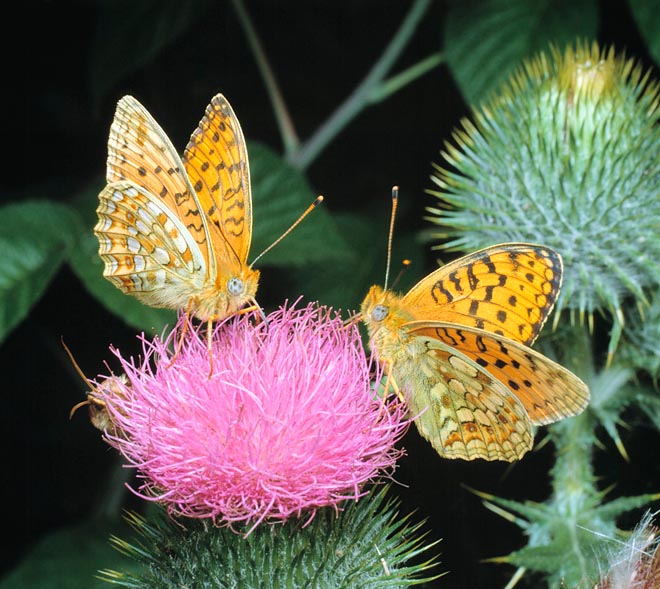
Argynnis niobe. Butterflies are important in Angiosperms pollination © Giuseppe Mazza
The order of the Lepidopterans (Lepidoptera) is an order of insects, second, as for size, only to that of the Coleopterans (Coleoptera), which is, in absolute, the greatest in the class of the Insects (Insecta).
To it are afferent the famous and well known “butterflies” and “moths”.
Taxonomically, the debate about their classification is not yet is not concluded, but in principle, nowadays the International Code for Zoological Nomenclature (ICZN) and the Royal Entomological Society tell us that the members of Lepidoptera are afferent to the phylum or type Arthropods (Arthropoda), subtype of the Antennates (Antennata), class of the Insects (Insecta), subclass of the Neopterans (Neoptera), cohort of the Pterygotes (Pterygota), superorder of the Enopterygotes (Endopterygota = Holometabolous) and order of the Lepidopterans (Lepidoptera).
These insects did appear in the Jurassic, Mesozoic or Secondary era, about 200 million years ago.
Presently, the entomological biologists indicate us the existence of about 80 families of butterflies and moths, of which 6 characterize the so-called diurnal butterflies, with splendid and multicoloured liveries, which are grouped into the Rhopalocers (Rhopalocera), whilst all others are nocturnal or crepuscular and are grouped as Heteroceres (Heterocera).
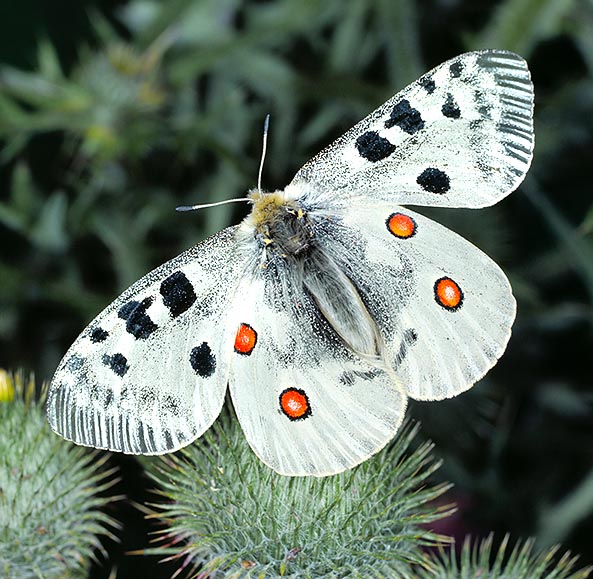
Like many diurnal butterflies, Parnassius Apollo has clavate filiform antennae © Giuseppe Mazza
This represents a very simple, functional and approximate subdivision, which is based on the style and the habits of life of the different species of butterflies and moths.
But, as we have already briefly said, the families in which the order subdivides are eighty, to which do correspond about 200.000 species, to which we must add some other tens of thousands of races or subspecies, not to forget the fact the biologists do discover, continuously, new “good species” of lepidopterans, diurnal as well as crepuscular, in the various continents, mainly in South America, in Africa, Asia and Oceania, where they populate pluvial forests, prairies and savannahs, whilst in other geographical regions (USA, Eurasia, Europe), the reach even the taiga deciduous forests and the alpine ones.
Specimens have been found also in the alpine meadows at 4.000 m of altitude.
Furthermore, we have to add that many species of butterflies have adapted to live in the urban gardens; and it is therefore easy to understand the complexity of the study of this order of insects, whose members, but the Poles, (even if they have found some up to the circumpolar area), are cosmopolitan.
This implies a continuous revision of the taxonomy at various hierarchic levels; and we have not to forget that the lepidopterans are not only animals with the showy liveries, the classical small animals which the biologist, with his head in the clouds, keeps studying since centuries for fields and forests, but have also key roles in the various ecosystems where they do live.Like the bees, in fact, they are fundamental to the Angiosperm (Angiosperma), plants, which reproduce by flower also by means of entomophily, acting, as the famous hymenopterans, as pronubial-pollinating insects.
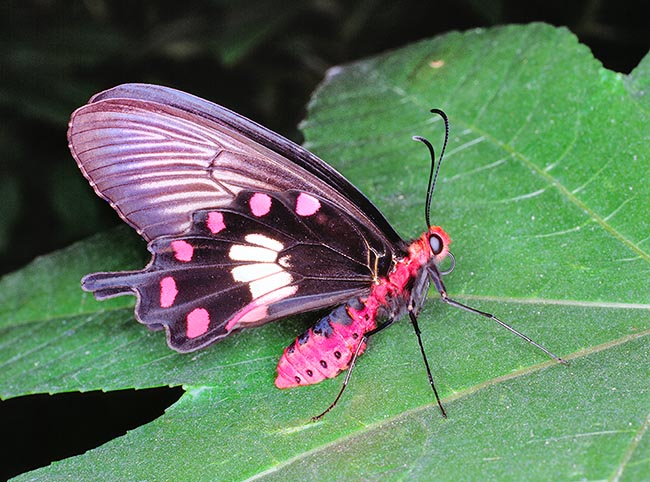
Pachliota aristolochiae. Diurnal butterlies, called Rhopalocers, often have showy colors © Giuseppe Mazza
Therefore, the study of all the extant species, and the subspecies or races, as well as their conservation, is indispensable for the preservation of most of the flora of the Planet Earth, because the angiosperms represent, nowadays the most evolved and the vastest group of extant plants; which means, ultimately, to save the “biosphere”. Finally, seen that almost all the officinal-edible domestic plants cultivated by the man and of which we nourish are angiosperms, it is clear how much these insects, as is the case of the bees, are essential for the agriculture.
We have then to keep in mind that there are two types of biologists who study and classify the insects in general and, specifically, the lepidopterans, the entomologists and the zoologists. Often, they have different points of view between them, not only about the taxonomy of these animals, but also about their ecology (autecology and synecology), like for the biogeography and the physiology. Though the agronomist is a sound scholar of insects, his field limits only to the species useful or dangerous to the agriculture, and has never given contributions to their taxonomy, as he is more interested to their agricultural impact. In the case of the butterflies, the discovery and the characterization of new species, tropical and subtropical, for instance, has always been done by the biologists (entomologists, zoologists) since at least three centuries, kind of like, referring to other classes of animals, the birds for instance, the ornithological biologists take interest to all the ornithic forms, whilst the veterinarians limit themselves to those bred in the poultry farming and specifically to the medical field.
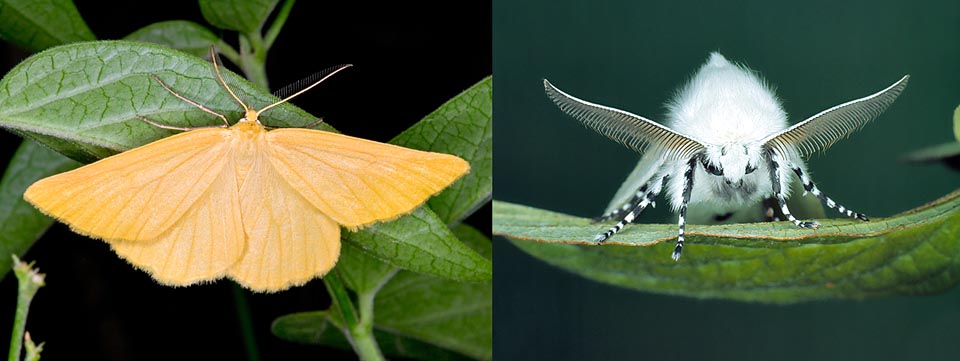
Night ones, here Crocota lutearia and a Leucoma salicis, are called heterocers. Usually they have modest liveries and ramified antennae © Giuseppe Mazza
But in the case of the lepidopterans the matter is even more particular, as the order is so ample that some entomological biologists do specialize only on the last lone, to the point to be defined “lepidopterists”, like the “coleopterologists” for the coleopterans, the “orthopterologists” for the group of the grasshoppers, locusts and crickets (the “orthopters”), and so on.
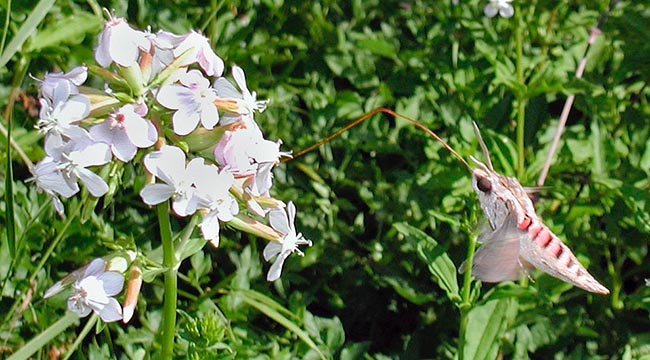
Typical lepidopterans suctorial proboscis allows flying Agrius convolvuli to suck nectar © Giuseppe Mazza
In the specific, we shall treat, in this introductory text, about the general characteristics of the diurnal and nocturnal butterflies, talking briefly about some more known family, without making the listing of 80 families and 200.000 species, as, even if the taxonomy is a cornerstone for the biologist, the space is not sufficient; furthermore, there are taxonomy texts which are specific for such a purpose, and, more, for this text, it would be something like wanting to know the history of the life of a person living in Rome or in Paris, by reading the telephone directory of these cities; obviously, in each text, the single species will be treated in all their characteristics.
At the end, being the lepidopterans characterized in their vital circle, like some coleopterans, the bees and the flies, by a complete metamorphosis called “holometabolous”, compared, for instance, to the odonates, that is, the dragonflies, as well as for other species of coleopterans and to the orthopterans, etc., characterized by an incomplete or partial, “hemimetabolic”, metamorphosis, we shall outline the Natural and Evolutive History of these two phenomena, which are part of the reproductive cycle of many insects, and the physiology standing at the base of them.
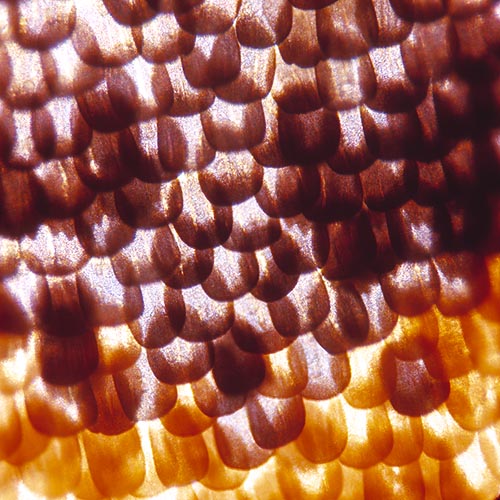
Butterflies scales are imbricated like roof tiles © Giuseppe Mazza
The lepidopterans are easily recognizable from all other insects thanks to some quite showy peculiarities, apart their external appearance, characterized by conspicuous wings (in the diurnal ones, the same are often much colourful) and the irregular flight, which appears even uncertain.
Typical of the lepidopterans is their sucking buccal apparatus, formed by an organ similar to a proboscis, long and thin, which, at rest, is rolled up on itself, called “suctorial proboscis” (“spirotromba”), by means of which the insect sucks the nectar or the lymph of which it nourishes; we shall treat shortly, more in detail, of such an organ.
Another characteristic of these insects stands in having the wings usually covered by thick and very thin scales, from which comes the name of the order Lepidoptera, compound word coming from the ancient Greek and meaning “wings covered by scales”; as is the case of the class of the Reptilians (Reptilia), where the subclass of the Lepidosauria, refers to the scaled reptilians (see texts Serpentes and Rhynchocephalia ).
Such structures bestow to these animals liveries with showy colours; we must emphasize that these colourations may have a chemical nature, thanks to chemical pigments which colour the wings, or physical, where the particular geometric disposition of the scales, determines a refraction of the light and its decomposition, the result of which is the whole of the colours observed; a similar phenomenon happens for other insects, as well as in the liveries of some birds. Let us examine in a more detailed manner the morphology of these elegant insects.
The head is usually small and this leads to the sides two great roundish eyes, composed by a very high number of “ommatidia” (the ommatidium is the fundamental optical unit of the insects eye), which, in the lepidopterans are always more than ten thousand per eye.
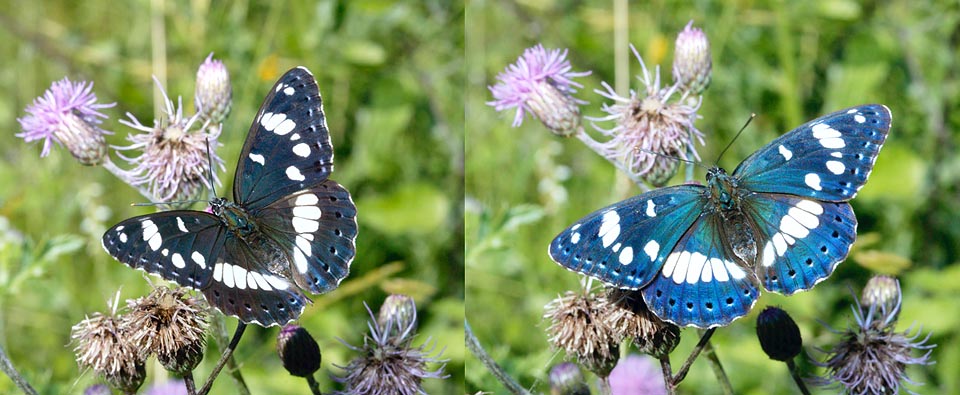
As seen in this Limenitis reducta, wings color doesn’t depend only on chromopigments but also on refrected light impact © Giuseppe Mazza
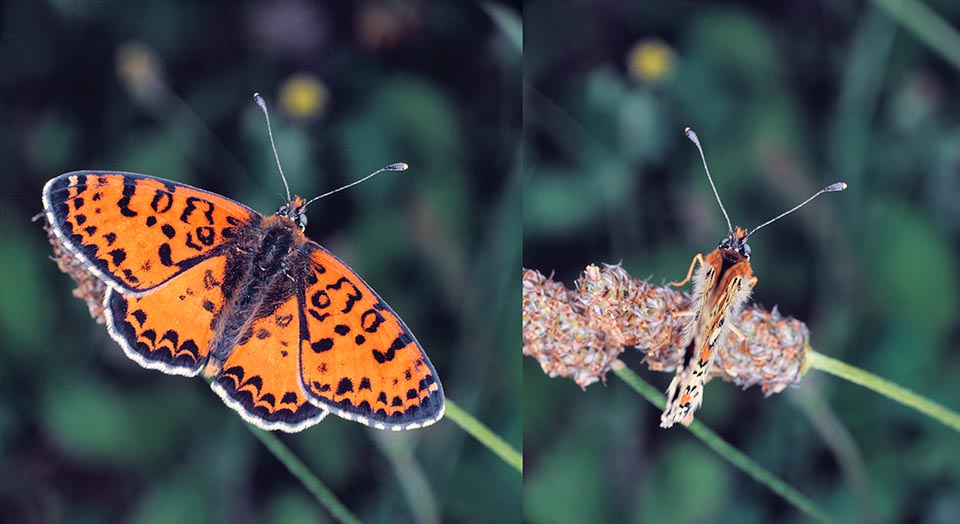
Such color changes have surely mimicry value too, as closing wings renders this Melitaea didyma invisible at once © Giuseppe Mazza
The antennae, two of them, are always elongated if compared to the body and formed by a very high number of segments; their shape, however, varies considerably depending on the groups. In the Rhopalocers (Rhopalocera), the six diurnal families, the antennae are filiform for almost all their length, ending in a short, but much evident, swelling, called “club” (the word rhopalocer , in fact, means clavate horns, where, with the term horns the antennae are meant).
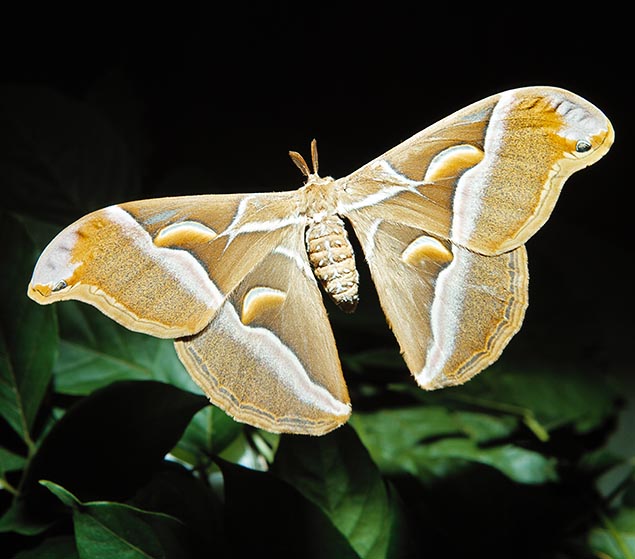
Chinese Samia Cynthia, naturalized in Italy and France, is one of the biggest nocturnal © Giuseppe Mazza
Otherwise, the antennae can be filiform, gradually clavate, or endowed on both sides of each segment, with several rather thin appendices, which render them similar to feathers.
When these formations are present, they are always more evident in the males than the females, which is a character of permanent sexual dimorphism.
In the Heteroceres (Heterocera), the crepuscular or nocturnal butterflies, called “moths”, the antennae can be filiform, unclubbed or comb-like; this difference, along with a more eclipsed livery of the wings, represents the main morphological differences between rhopalocers and heterocers.
The buccal apparatus of the lepidopterans has an extremely characteristic structure; the mandibles are atrophied, whilst the jaws are fused together and form the suctorial proboscis.
This sucking organ looks like an elongated tube, very thin and exceptionally elastic, which, when at rest, is kept rounded on itself in concentric spirals under the thorax; the spirals resemble to the spring of a clock.
When it is utilized for sucking the nectar or the vegetal lymph, the suctorial proboscis, which, at times, is longer than the entire body of the animal, is flexed out and kept perfectly straight, or only slightly, curved.
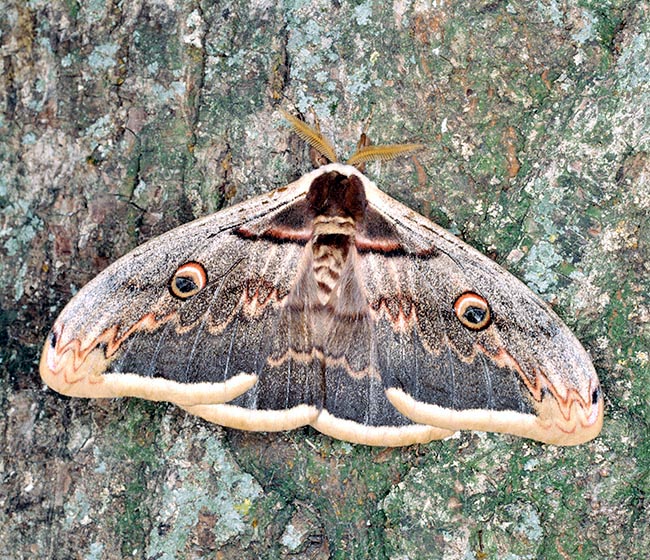
Like our Saturnia pyri which may have a 15 cm wingspan © Giuseppe Mazza
The thorax and the abdomen do not have any particular morphological characte- ristics, protected by teguments of average hardness; the thorax in various species is thick, rather high and compressed on the sides, whilst the abdomen is usually oblong and convex in the upper part.
Both are always covered by a more or less long and abundant hairiness which, whilst is usually uniform in the diurnal butterflies, in the nocturnal ones it often forms elegant and well harmonized patterns compared to those, not so striking, of the wings; in this regard, amongst the most beautiful stand those of the Sphingids (Sphingidae), a tropical family of macro-heteroceres.
The wings are much wide and are more diversified than in any other order of insects, but, maybe, the coleopterans only, and do hold a remarkable systematic interest for their shape as well as for the disposition of the nervations and of the drawings formed by the scales, useful to the entomological biologists for their classification.
The two forewings are always bigger than the hindwings, also double, to which they are partially overlapped; in most of the heteroceres (nocturnal), then, the forewings adhere to the hindwings, thanks to the presence of some particular structures which are absent in most of the rhopalocers.
Both forewings may have along the edges, incisions having a characteristic shape, whilst in the hind wings are often observed tail-like extensions and directed rearwards.
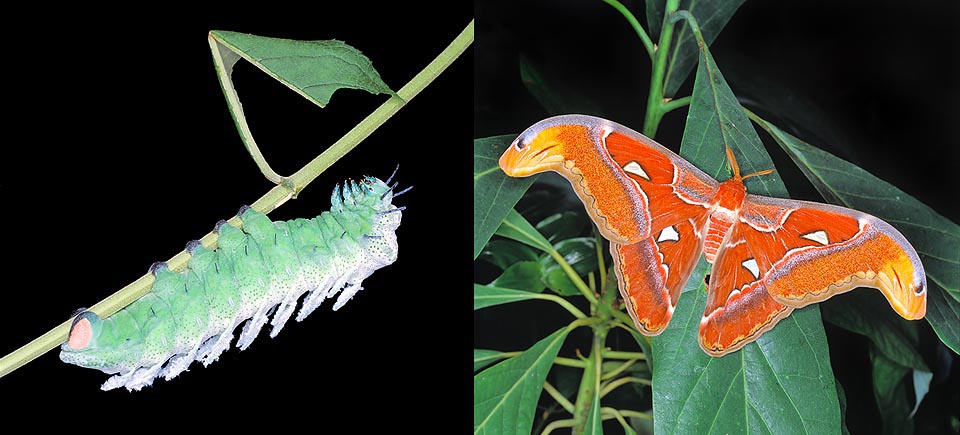
Nothing compared to this akin, Attacus atlas, called “cobra moth” due to the disturbing wings tip of almost 30 cm with 15-17 cm caterpillars © Giuseppe Mazza
The alar nervations are longitudinal and their purpose is, like all other insects, that of supporting the wing.
The zones delimited by them, called “small cells”, are indicated with a specialized terminology that allows a precise description of the patterns formed by the scales.
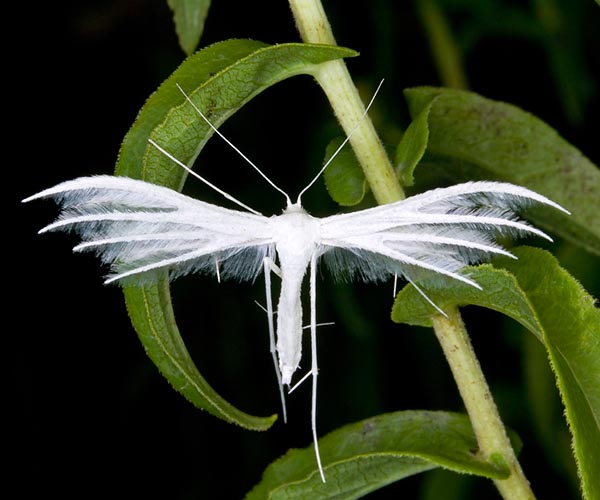
Conversely, also our fields tiny Pterophorus pentadactyla is a lepidopteran © Giuseppe Mazza
The presence of scales on the wings is one of the most remarkable characteristics of this order, for which it is worth to dedicate them a closer and more accurate examination.
The small cells are inserted into the wing by means of a very tiny basal peduncle, which, however, does not adhere there too tenaciously.
As a matter of fact, everyone knows that when seizing with the fingers the wings of a butterfly, these lose abundantly a fine powder formed, rightly, by a great quantity of scales which has flaked off; if the loss is remarkable, the flying capacity of the insect will be seriously compromised.
If we observe at the optical microscope, or at the stereoscope, the wings of a lepidopteran, we note that the scales are not contiguous between them, but are imbricate (like the tiles on a roof), that is, placed in such a way that the apex of one of them covers the base of the following one.
Strongly flattened, the scales of the wings of the lepidopterans have, in most cases, a grooved surface and an oblong shape, at sub-parallel sides; their apex is usually indented; the shape is determined by the necessity of not leaving empty spaces between a scale and another, whilst the grooving and the apical small teeth guarantee a better reciprocal adhesion. Another phenomenon which amazes the biologists while observing at the microscope the wings of a butterfly is the difference they see between the colours as seen at the microscope and those visible with the unaided eye; this, as already briefly said before, is due to the fact that not always the wonderful colours of the wings, especially the metallic or iridescent ones, have a chemical base, that is determined by chromo-pigments, but are, on the contrary, due to the refraction of the light, therefore to a physical phenomenon.
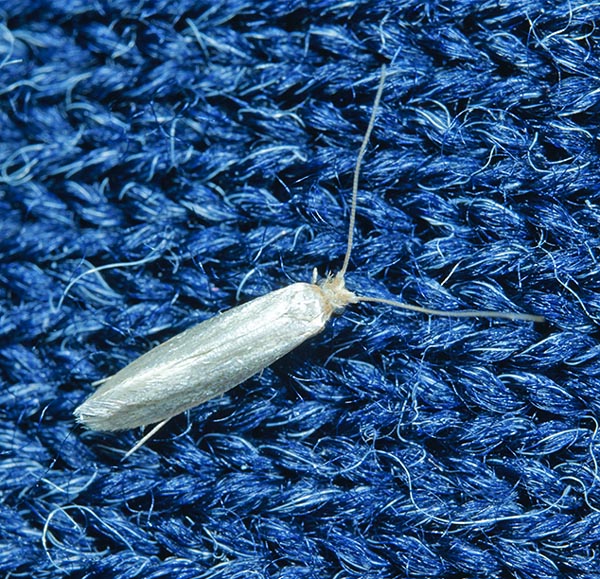
Also Tineola bisselliella, the common clothing moth, is a lepidopteran © Giuseppe Mazza
We can realize this by observing with an unaided eye the wings of a butterfly with metallic tinges from different perspectives: we shall assist then, while varying the animal position, to showy changes of colour.
It will be good however to remark, concluding what said till now about the wings of the lepidopterans, that they are not always by a scaly cover: some species, in fact, have transparent wings, whilst, in other ones, the females do not have it.
The lepidopterans’ legs are covered, like the body, by very thick hairs even if shorter.
Though not particularly thin, the legs are always very frail, and particularly frail is the basal articulation of the femur; anyone, who has handled butterflies when a kid, remembers quite well that the legs detach easily.
As per the dispositions and the most recent systematic criteria of the ICZN and of the Royal Entomological Society (at least till a few years ago), the order of the Lepidopterans (Lepidoptera) is, in turn, subdivided into the two suborders of the Heteroneurans (Heteroneura Tillyard, 1918) and the Homoneurans (Homoneura Wulp, 1891).
The first ones, to which belong almost all known species, and in particular those called “butterflies”, have forewings veins quite different from those of the hindwings; the second ones, on the contrary, do not have suctorial proboscis and have nervations which are analogous in both pairs of wings.
Presently, the homoneurans, which represent an intermediate group between the Lepidopterans and the Trichopterans (Trichoptera), are included by many systematists in a separate order, that of the Zeuglopterans (Zeugloptera). So, deprived of the homoneurans, the lepidopterans subdivided again in two suborders, that of the Ditrysians (Ditrisa) and that of the Monotrysians (Monotrisa).
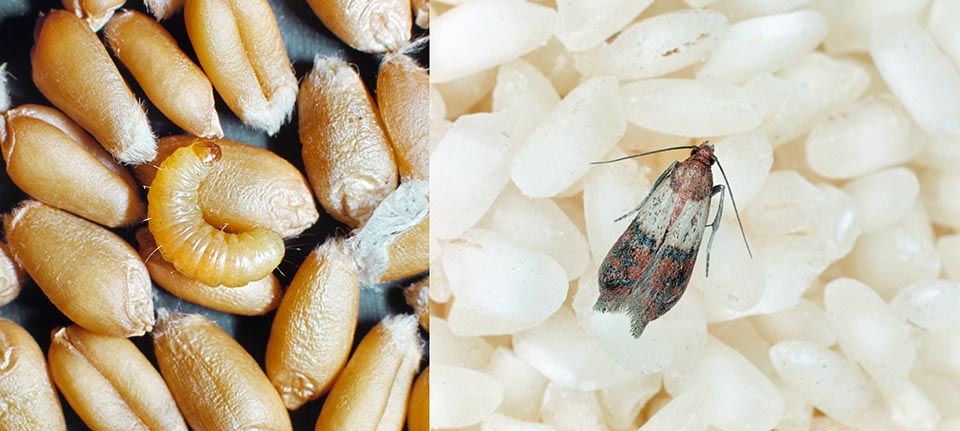
Other unwelcome homes and stores guest is Plodia interpunctella, whose larvae (left) damages wheat, rice and other foodstuff © Giuseppe Mazza
This last one, which includes only a limited number of little known species, is characterized by only one genital opening in the female, whilst in the ditrysians we see two different orifices, one for the copulation and the other for the oviposition.
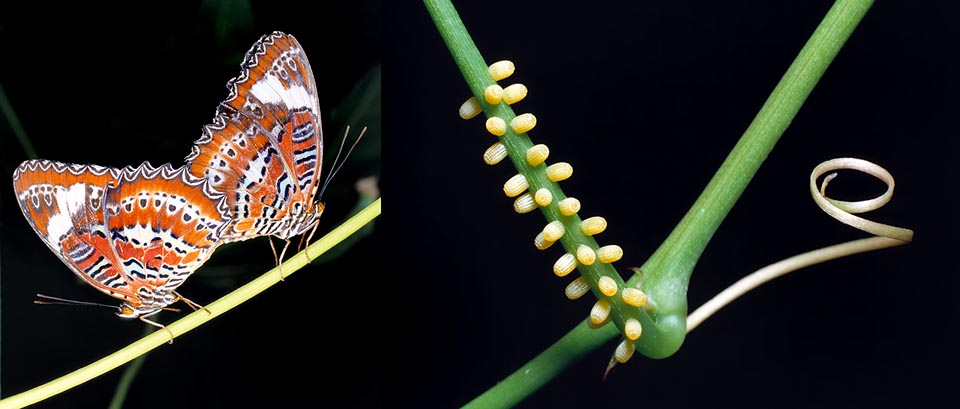
Mating and eggs of a Rhopalocer, the Cethosia penthesilea, common in Australia © Giuseppe Mazza
Only at this point in the ditrysians, which include the most known species of butterflies, is done the great distinction between the two greatest and most known groups of lepidopterans, those, already mentioned, of the Heterocers (Heterocera), the nocturnal or crepuscular butterflies, called moths, and that of the Rhopalocers (Rhopalocera) commonly called diurnal butterflies by some entomological biologists and differing between them due to the morphological characters of the antennae, previously mentioned.
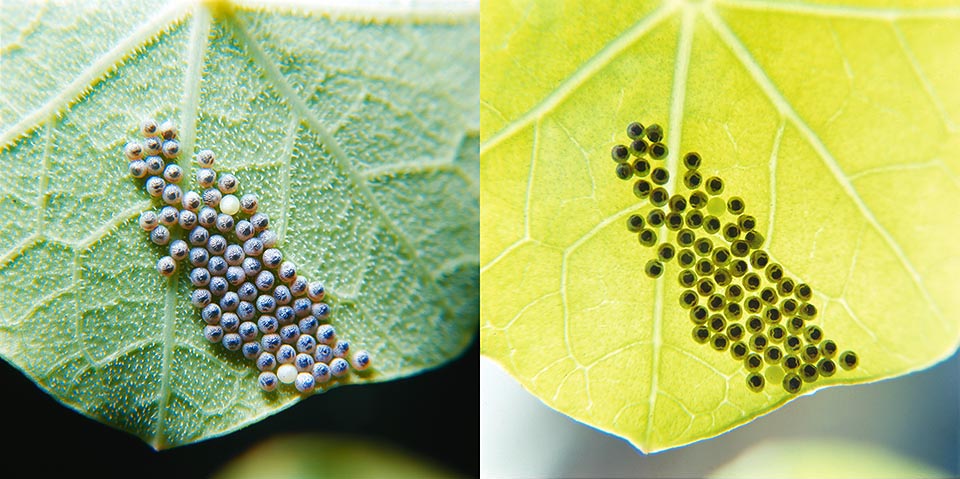
Heterocer Plusia gamma eggs, with forming embryos evidenced in right backlighting © Giuseppe Mazza
The method of the oviposition, as well as the aspect and the structure of the various “pre-imaginal” stages of the lepidopterans, are extremely diversified, even if carefully studied by the “lepidopterists”, so much that, among the great orders of insects, that of the Lepidoptera is the only one where the study of the various pre-imaginal stages has reached a satisfying level.
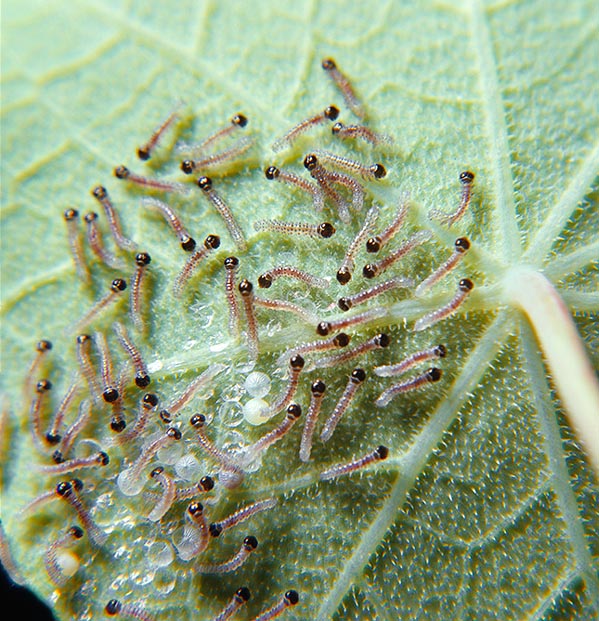
Eggs hatching with small caterpillars of Plusia gamma © Giuseppe Mazza
But let us begin examining the various types of oviposition, whilst the physiology of the complete “holometabolous” metamorphosis and the differences with the gradual or incomplete “hemimetabolic” one will be treated later on in this text.
Here, just incidentally, the gradual incomplete metamorphosis is in reality defined by the biologists as “hetero-metabolic”, and to this are afferent two subtypes, the paurometabolic, that is, pure, and the hemimetabolic, typical of those insects where the neanids (larvae) and the immature stage of “nymph” develop in habitat totally differing from the adult one. For instance, in the dragonflies and in the anopheles mosquitoes, where the naiads (the aquatic larvae) and the nymph, live in water, and then, once adult, carry on an aerial and sub-aerial life.
Going back to the strategies of oviposition, we see that in some species the females have a chitinous “ovipositor” which is used for piercing the vegetal tissues, inside which the eggs will be laid. As for all insects, also in the lepidopterians the eggs are rich of deutoplasm (yolk), are centrolecithal and with superficial meroblastic (partial) segmentation. In many other cases, the eggs are simply attached to the stems of to the leaves of the plants, singly as well as in voluminous clusters; this last is, for instance, the method utilized by the very dangerous cabbage butterflies, for instance the Small white (Pieris rapae) and the Large white (Pieris brassicae), diurnal butterflies of the family of the Pierids (Pieridae).
In other cases, the eggs are simply laid close to the host plant, and there are even some butterflies, such as the Moths of the family Hepialidae, which drop the eggs in flight, leaving them to fall wherever it happens in the humid grass.
From the eggs then hatch, after a variable time depending on the species, the larvae, indicated with the name of “caterpillars”, which are eruciform, polypod, cephalic, larvae.
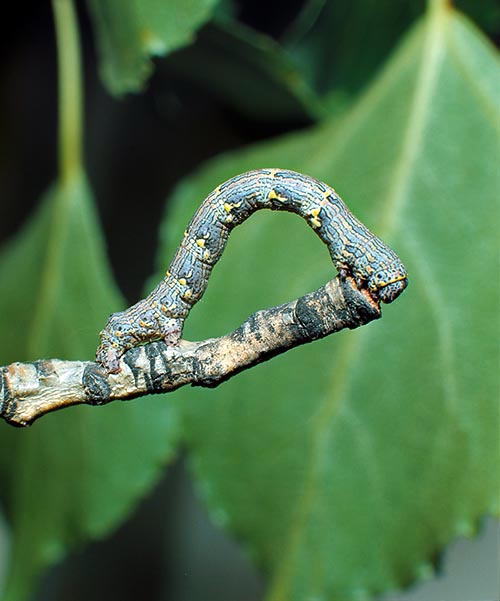
When moving, Geometrids caterpillars seem to measure the branches © Giuseppe Mazza
The huge variety of look and structures observed in the caterpillars is not less than that which can be found in the adults, and consequently their determination is fairly easy.
Basically, we can say that the caterpillars have always a cylindrical-elongated structure and that, besides the legs in the strict sense, which have a usually sub-conical shape, they have a variable number of “false legs”, appendices of the abdominal segments usually equipped with a sucker.
These false legs, or false feet or “prolegs”, allow the caterpillars an excellent adherence to whatever type of surface and cause their odd jerky gait; the caterpillars, in fact, move like an “accordion”, in the following way: staying still with the front part of the body, they advance with the prolegs, compressing to the maximum the ventral segments, then, keeping the hold with the last couple of pseudopods, they stretch ahead, ready to begin a new locomotory cycle; also in this case, having been able to record by means of the cinematography the movement of the caterpillars, during a whole day, besides the observation on the field, has been a help for the entomological biologists for decrypting the capacities of locomotion.
In a family of heterocers, the Geometrids (Geometridae), the caterpillars have at the most two pairs of prolegs, placed towards the hind extremity of the abdomen, and so they advance with the false feet, bend the body upwards carrying the apex of the abdomen in contact with the thorax, after which they stretch again ahead, with a way of proceeding similar to the movement of a hand which measures the earth by spans (the span is an ancient unit of measure, given by the distance between the tip of the thumb and that of the little finger, in an open adult’s hand).
The name “geometrids”, which, from the ancient Greek means “earth-measurers”, has been given them by the taxonomists rightly for the above reason.
The larvae of many species of butterflies are whitish and with a translucent skin; however, in most cases, their cuticula has bright and intense colours, often arranged to form showy patterns, the whole with the purpose of signalling or to communicate in code for their predators (entomophagous insects, frogs, reptilians, birds and insectivorous mammals), for indicating them the danger and the poisonousness of their flesh, acting as active “phaneric” signals, which do not stand inside the Batesian mimicry, that is, passive (the mimicry used for escaping a predator, camouflaging and hiding), but in the Müllerian one, that is active, where they behave, therefore, as “aposematic” signals of danger (see text Serpentes ).
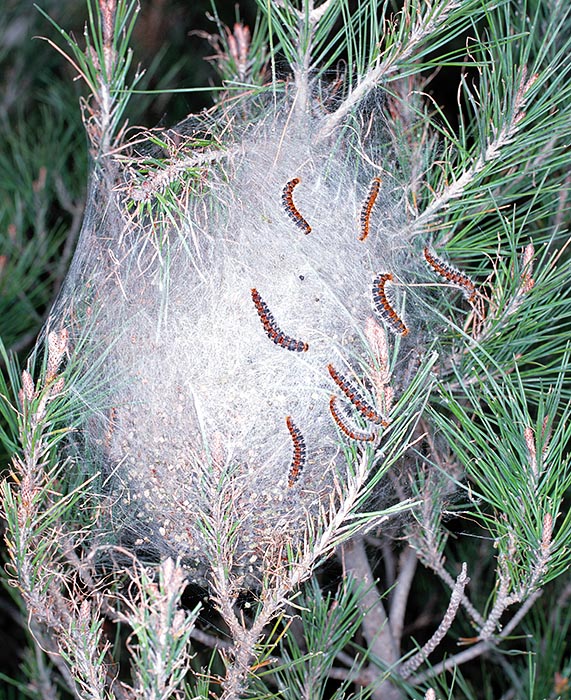
Thaumetopoea pityocampa caterpillars eat pines, building nests on the branches © Giuseppe Mazza
Besides this, we may observe also some strange appendices of various nature and shape; particularly odd are those placed towards the apex of the abdomen, diverging upward and directed backward, of the species Dicranura vinula.
In case of danger, this caterpillar exhibits, outside from the two appendices, some bright red filaments, which are moved in front of the aggressor for intimidating purpose.
Finally, many species are covered by thick and long hair.
Almost without any exception, the caterpillars are phytophagous, that is they feed on plants; most species live in open air, eating the leaves of the most varied plants, with an extreme greediness.
For eating the leaves, the caterpillars reach their border and chew it; some small species, however, enter the pages of the leaf and dig internal galleries called “mines”.
There are however also caterpillars which eat the pulp of the fruits, such as the Carpocapsa pomonella, whose caterpillar is known with the common name of “Codling moth”, whilst others, such as the Wood moth (Cossus ligniperda), big caterpillar, similar to a coleopteran larva, dig galleries into the wood of the trees, altering in the entering point the exchange structure.
The caterpillars of many species do live isolated, but in other cases they form numerous colonies.
Quite odd are the colonies of the dangerous Pine processionary (Thaumetopoea pityocampa), whose individuals move in single file.
The duration of the larval stage is much variable; whilst some species remain at the stage of caterpillar for a few days only, in others, like the already mentioned wood moth, this stage may last even two years and more.
We remind that the simplified scheme of the vital cycle of the lepidopterans, like for all “holometabolous” insects, that is with total metamorphosis, can be sumamrized as follows: egg–àlarva (caterpillar)–àchrysalis or pupa (which, in the lepidopterans is a “pupa obtecta”; pupa comes from the Latin and means “puppet”), in a ampler sense called nymph-àadult.
The pupa obtecta is the one where the appendices are evident, but attached to the body by means of a covering cuticle.
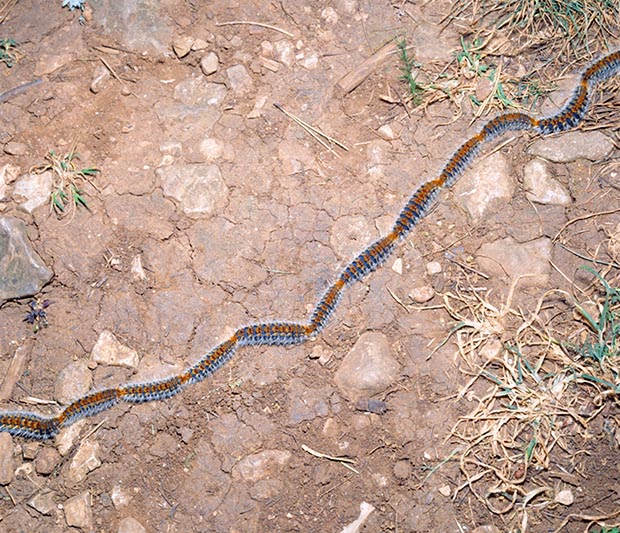
Called processionaries because moving attached. Very urticant hairs © Giuseppe Mazza
Substantial differences are observed in the passage to the stage following the larval one in the two great groups of lepidopterans, the rhopalocers and the heteroceres.
As a matter of fact, the nymph, called chrysalis or pupa obtecta, does not, in the first ones, enclose in a protecting cocoon (typical of the heteroceres) and waits for the final moult simply laying on the ground, or suspended on the vegetation by means of a peduncle which takes form at the apex of the abdomen.
The chrysalises, usually coated with a very solid chitinous armor (much more robust than that of the caterpillar as well as that of the adult), do have a structure completely different from that of the caterpillars and have, in embryo, all the anatomical parts which will then fully develop with the imaginal stage called “imago”.
The wings, short, are folded over the abdomen, and cover the same in the basal part, whilst the legs and the antennae are gathered on the belly and are strongly adhering to the body; the colouration is always weak looking.
In the nocturnal butterflies, or moths, afferent to the group of the heteroceres, the chrysalis or pupa obtocta digs deeply into the ground, or, even more frequently, builds a protective cocoon, with silk filaments, produced by specific labial glands called “serigenous”, similar to those of the spiders.
As we all know, historically the silk is one of the most prized tissues among those utilized and commercialized by the human being; this is, rightly, produced by a caterpillar known as Silkworm (Bombyx mori), species of the family of the Bombycids (Bombycidae), native to eastern Asia (China, Japan, etc.) and strictly related to the White mulberry (Morus alba), plant afferent to the family of the (Moraceae), its only nourishing plant.
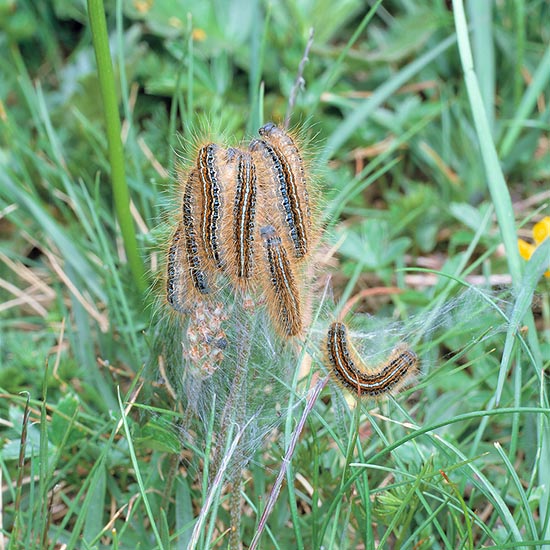
Other species like Malacosoma Neustria content of field grass © Giuseppe Mazza
For getting the silk, man rightly breeds this butterfly, furnishing the caterpillars the food they need; once they have built their silk cocoon and have made the chrysalis inside them, the animal is killed with the heat and the cocoon is unravelled; each cocoon, as an average, is composed by about one kilometre of floss.
The whole of these techniques, which have a millenary origin (the silkworms were already bred in the ancient Japan, at the time of the samurais), later on rationalized over the years, go under the name of sericulture, a specialization of the zoo-cultures.
Only a very limited number of chrysalises are kept alive in these cultures in order to allow the formation of a new generation; one unique female of butterfly of the species Bombyx mori may lay from hundreds to five thousands of eggs.
A calamity for the silkworm breeders is the disease called “Pébrine”, called also parasitic atrophy or petechial disease of the silkworm, caused by a ciliated protozoon, the Nosema bombycis, which the caterpillar ingests while eating the mulberry leaves; this protozoon interrupts irreversibly the production of the “slime”, or silk filament, done by the larvae, this disease did appear in 1850 in France and in Italy, precipitating the collapse of the silkworm sector.
In other species, the silk of the cocoon, often mixed with soil, is less abundant and much less valued. Once the time has come for the final moulting to perfect insect, or “imago”, the chrysalis breaks the cocoon from inside, or melts it by secreting appropriate enzymatic substances.
The perfect adults, after getting free from the nymphal exuvia, which takes place some time after the exit from the cocoon, after that the dried up wings, are spread, assume life habits totally different from those of the caterpillars; having no chewing apparatus, well developed in the caterpillars, they limit themselves to suck the nectar from the flowers or the lymph from the plants with their suctorial proboscis; the complete metamorphosis has changed also the digesting apparatus, thus establishing a new “alimentary ecology”.
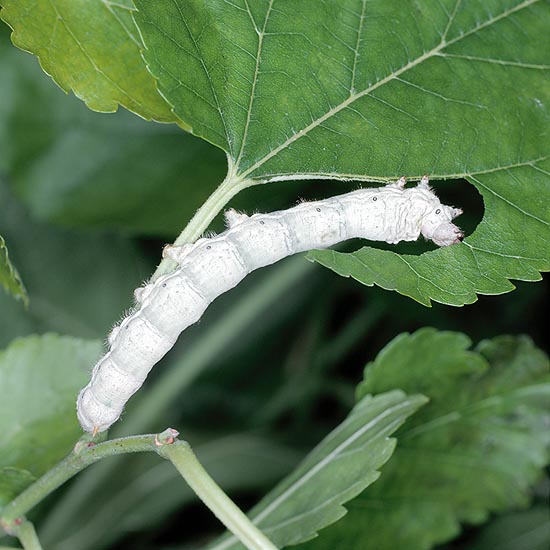
Silkworm (Bombyx mori) caterpillar instead loves mulberry © Giuseppe Mazza
Curious is the case of a great heteroceran, well known to the entomological biologists, afferent to the family of the Sphingids (Sphingidae), the Death’s-head hawkmoth (Acherontia atropos), so called due to a drawing resembling to a skull placed on the back: this butterfly, in fact, enters the hives and nourishes of honey, often prompting angry reactions from the bees.
The diurnal butterflies, during their periods of activity, flutter continuously, alighting only occasionally on the flowers or on the soil, when resting, the wings are kept in contact each other by means of the upper surface, thus resulting directed perpendicularly upwards, showing only the lower face.
This way of keeping the wings resting is typical of the rhopalocers; in the heteroceres, on the contrary, the resting wings keep in contact by means of their lower edges, thus forming a sort of a roof, leaving only the upper surface visible.
The flight of the diurnal butterflies is particularly light and irregular, consequently the predators’, mainly insectivorous birds, seizing results rather difficult.
Furthermore, always for discouraging the predators, almost all butterflies are imbued with substances which render their taste disgusting; in order not to be mistaken with other edible insects, the butterflies are almost always decorated with very showy colours, which are not at all mimetic, but facilitate their recognition, as mentioned before.
The nocturnal or crepuscular butterflies differ as habits from the diurnal ones and have a much heavier and more regular flight. In addition to this, the moths stay perched longer than their diurnal sisters, and whilst these last ones utilize mainly the nectar of the flowers as food, the first ones eat especially the lymph exuded by the plants.
Let us talk now about the main groups and species, seen the exceptional vastness of the order, it is not possible to realize in an introduction a comprehensive view of all the families.
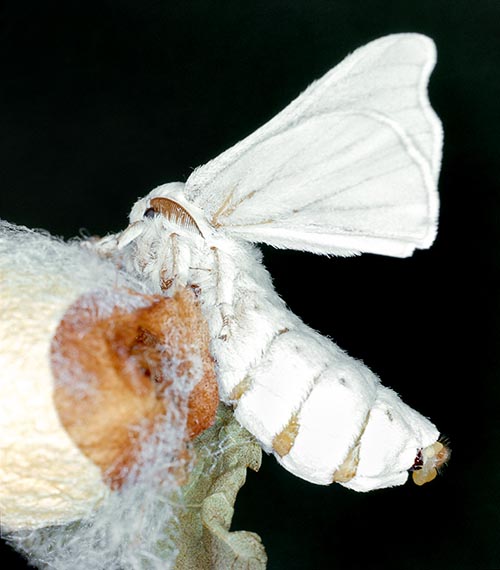
It’s the only domestic lepidopteran. Females may lay even 5000 eggs © Giuseppe Mazza
Particularly known, amongst the diurnal butterflies of the rhopalocers, are the Vanessas, belonging to the family of the Nymphalids (Nymphalidae), of quite big size and with an elegant livery, usually having no metallic shades.
The best known species of the family are the Vanessa Io, also called European peacock (Inachis io), adorned at the upper apex of both wings with a huge colourful spot similar to an eye or to the ocelli present on the tail of the male peacocks; it is found in the temperate areas of Europe and Asia.
The Mourning cloak, or Camberwell beauty (Nymphalis antiopa), with its burgundy coloured wings, amply bordered with witish, is present in North America and in Europe; other species are the Cosmopolitan, or Painted lady (Vanessa cardui), present in all continents but Antarctica, the Red Admiral, also called Volcano (Vanessa atalanta), spread in Europe, North America and Asia, in the temperate areas and the Small tortoiseshell (Aglais urticae, by some authors wrongly called Nymphalis urticae), present in the temperate areas of Asia and Europe, even if it has almost completely disappeared in the western part of Europe during the last ten years.
Resembling to the Nymphalids (Nymphalidae), are the Morphids (Morphidae), with the wings of a wonderful iridescent blue colour, like in the Morpho menelaus, great sized lepidopteran with a wingspan of even 18 cm, present in Central and South America, in particular in Mexico, Costa Rica, Brazil and Venezuela.
Other wonderful butterflies, both local and exotic, are afferent to the vast family of the Papilionids (Papilionidae); the most known species, amongst those present in Italy, is the Old world swallowtail ( Papilio machaon ), with yellow fore wings, with black veins and lines, which stands out especially of its odd peduncle in the hind wings which, besides the colours of the fore ones, have a blue marginal belt and an orange dot near the internal apex of this one; the yellow colour in some cases is very pale, almost dirty white. Similar to the Old world swallowtail and equally common, but less elegant, is another species of the genus, the Papilio podalirius .
Another quite well known rhopalocer is the Cabbage butterfly (Pieris brassicae), whose fame is not due, however, for the livery, which is almost uniformly white, but for the serious damages this butterfly causes to the cabbage “cultivar” cultivations; it is a Palearctic species, and for this reason is found all over the continental Europe, moving south up to northern Africa.
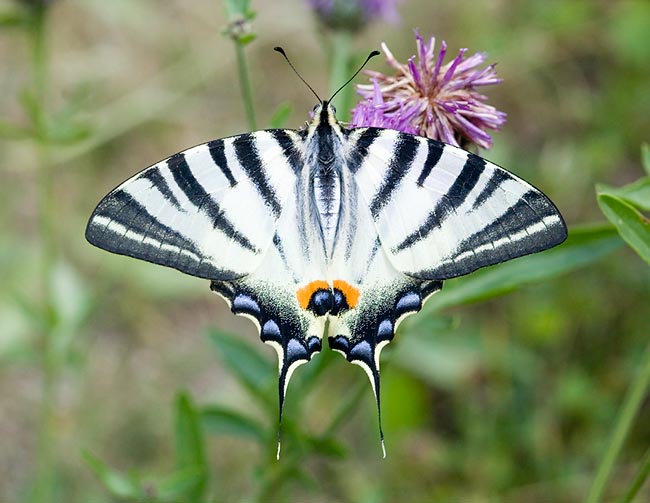
Sail swallowtail (Iphiclides podalirius) like macaon belongs to the showy family of Papilionidae © Giuseppe Mazza
Other important families of rhopalocers are the Satyrids (Satyridae), very close relatives to the already mentioned Nymphalids (Nymphalidae).
Still among the rhopalocers, we have the Lycaenids (Lycaenidae), which include small sized species often coloured mostly in light blue or orange, for instance the Lycaena virgaureae, one of the most colourful European diurnal butterflies, and the Hesperiids (Hesperiidae), with their unusually solid appearance, like in Pelopidas mathias present in eastern Asia (up to the Philippines), as well as in tropical Africa and in Arabia; the butterflies of this last family in certain ways seem to be intermediate between the two groups of rhopalocers and heteroceres.
This last group (the heteroceres), much more ample and complete than the previous one, does not, in reality, include only nocturnal species, but also species having habits mainly diurnal.
Among the local, or European, species, the best known diurnal ones belong to the family of the Zygaenids (Zygaenidae); very common is the Zygaena filipendulae, with dark blue wings spotted of bright red. However, among the Italian heteroceres, the most beautiful and greatest species belong to the families of the Saturniids (Saturniidae) and of the Sphingids (Sphingidae).
The Giant peacock moth (Saturnia pyri), known also with the local name of Pavonia, is, in fact, the biggest European lepidopteran, having a wingspan of more than fifteen centimetres. It is a grey-brown butterfly, variegated of black, with elegant ocellated spots and with whitish back edge of the wings.
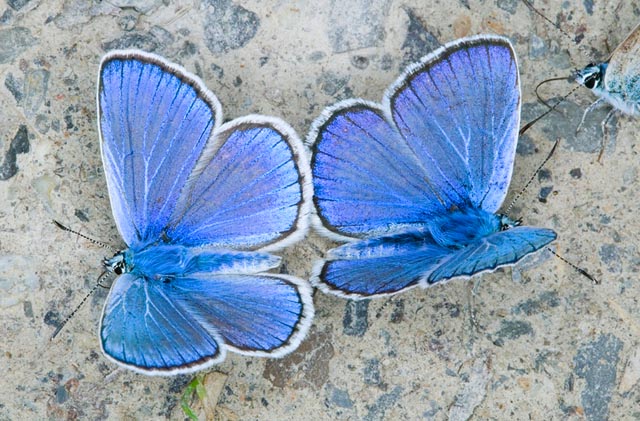
Polyommatus escheri. In their own small world also Lycaenidae have showy liveries © Giuseppe Mazza
It is also very nice another local saturniid, the Ailanthus silkmoth, or Philosamia (Philosamia cynthia or Samia cynthia), native, however, to the Far East: Russia, China and Japan; whilst among the sphingids the best known species is the already mentioned Death’s-head hawkmoth (Acherontia atropos), Palaeotropical species, and for this reason found in the Mediterranean and in the Afrotropic regions; this lepidopteran has elegant patterns also on the body.
Much known are also the species afferent to the huge family of the Noctuids (Noctuidae), where a well known example is the Catocala conjuncta, circum-Mediterranean species, present in Europe, in North Africa up to the Middle East; other family is that of the colourful Arctiids and many others, among which some particularly dangerous for the agriculture, the horticulture and for the food products; among these, deserve a citation the family of the Tineids (Tineidae), to which belong the moths, such as the Meal moths (Pyralis farinalis and Ephestia kuehniella) and many others, which when caterpillar, are called “moths” and cause serious damages to the clothes stored in the closets as well as to the preserved foods; or the family of the Tortricids (Tortricidae), commonly called tortrix moths due to the type of activity characterizing them, which include several species dangerous for various types of fruits; an example is the Peach moth (Cydia molesta), native to eastern Asia, and then, later, easily diffused in Australia, Americas and western Europe, among which, in Italy by the beginning of the XX century, extremely dangerous for the plants producing drupes.
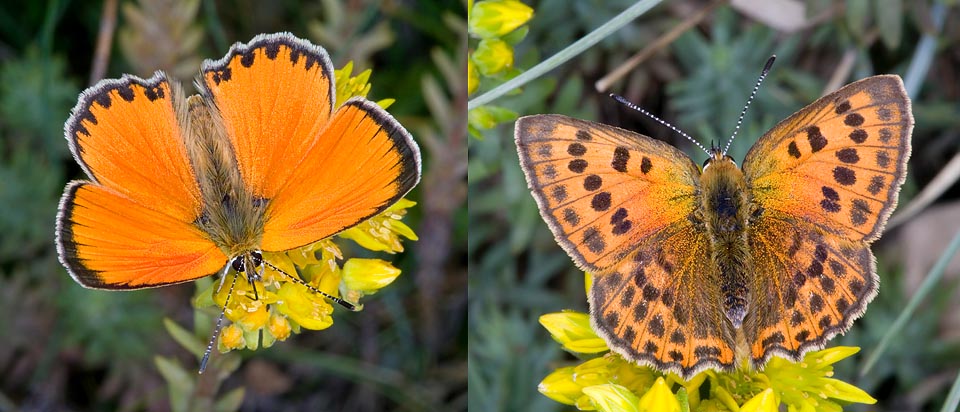
Same family Heodes virgaureae has big sexual dimorphism. The male, links, is our pastures jewel © Giuseppe Mazza
Another family is that of the Lasiocampids (Lasiocampidae), which are capable to cause serious damages to entire woods; amongst these we find the Oak eggar (Lasiocampa quercus), present in Europe and Asia Minor; in Italy is present in the whole territory, but Sardinia.
Among the useful families, stands that of the Bombicids (Bombicidae), to which belongs the previously mentioned Silkworm (Bombyx mori), which can be rightly considered the only lepidopteran which has become a true and proper domestic animal.
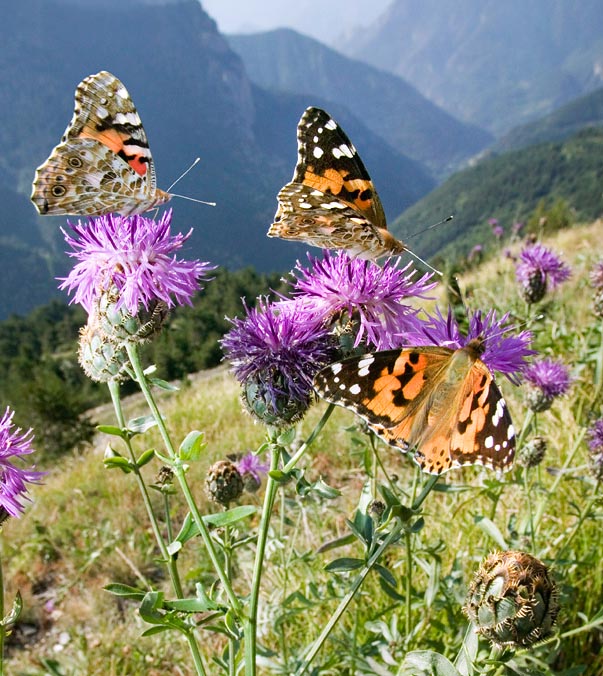
Vanessa cardui, Nymphalidae family, is a wonder of Alpine valleys © Giuseppe Mazza
We end this short overview on the various families, genera and species of lepidopterans, with two particular cases. The first concerns a species anticipated and, under some aspects, indirectly discovered, by the great English biologist Charles Darwin.
This scientist, while studying a Madagascar plant, afferent to the family of the Orchids (Orchidaceae), the Christmas orchid or Darwin’s orchid (Angraecum sesquipedale – Thouars, 1822), of which he cultivated in his greenhouse in England some plants he had received as a gift by the botanist James Bateman, came to assume the following: these orchids which have candid white hexameric flowers, have bright green nectaries, long more than 30 cm, where only the bottom, for a total of 3-3,5 cm of length, is full of nectar.
This particular structure and the colour of the nectaries made the English biologist reflect about the fact that the Malagasy entomofauna had to conceive the existence of nocturnal, heterocerous, butterflies, endowed of a very long suctorial proboscis, ecologically suitable for these flowers.
This individual was to have huge size of the body and of the suctorial proboscis if compared to the specimens of Sphingids (Sphingidae) present in UK.
The scientific community of the time, still critical on the validity of the theory “on the Origin of the Species, through Natural Selection”, thought that the English biologist, now elderly, had done a gross mistake; in support of Darwin came another English biologist, A.R. Wallace, who proposed a sphingid of tropical Africa, as possible pronubial of this flower, the species Xanthopan morgani. But, only in 1903, the entomologists K. Jordan and L.W. Rothschils discovered in Madagascar the race Xanthopan morganii praedicta, as Darwin had correctly predicted.
Other sphingids with suctorial proboscises of the same length, have been discovered later on, in the XX century, in the Brazilian Amazonian forest.
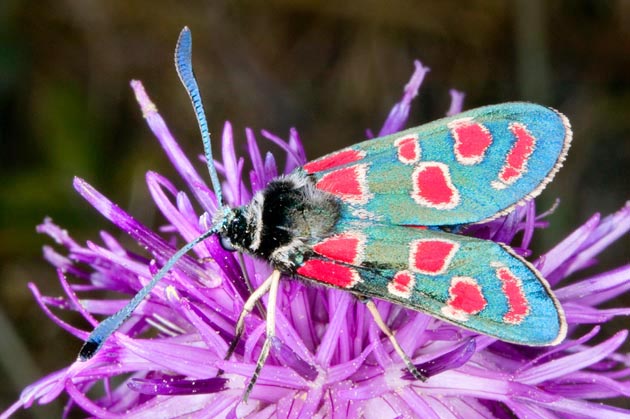
Same flowers are visited by odd Zygaena carniolica, Zygaenidae family © Giuseppe Mazza
Nowadays, some authors think that the race Xanthopan morganii praedicta, is to be obsoleted, confining it in the good tropical African species of Wallace, the Xanthopan morgani, other scholars persist in keeping them separate; however, when completely stretched out, the suctorial proboscis of these lepidopterans reaches the length of 30 cm!
If by the beginning of summer, you observe a buttercup, such as the Ranunculus asiaticus, simple flowers, much colourful, of Asian origin, afferent to the family of the (Ranunculaceae), quite often you will note that it is inhabited by a certain number of small butterflies.
These are the Micropteryx calthella, the most primitive lepidopterans. This is the second particular, mentioned case; these insects have a structure more primitive than that of the trichopterans and some entomological biologists classify them in a separate order of insects.
The tiny Micropterygidae, have buccal parts suitable for biting, of the same type of those of the cockroach, whilst in all other lepidopterans, as already said, the mandibles are atrophied, whilst the jaws are fused together and form the suctorial proboscis. The listing of all the families and the genera not to forget the species, should be so long to fill up several books, but for our aim, what here briefly mentioned is more than enough; the reader will find all information about the single species in the relevant texts.
Natural and Evolutive History of the Reproduction and of the Semiochemistry
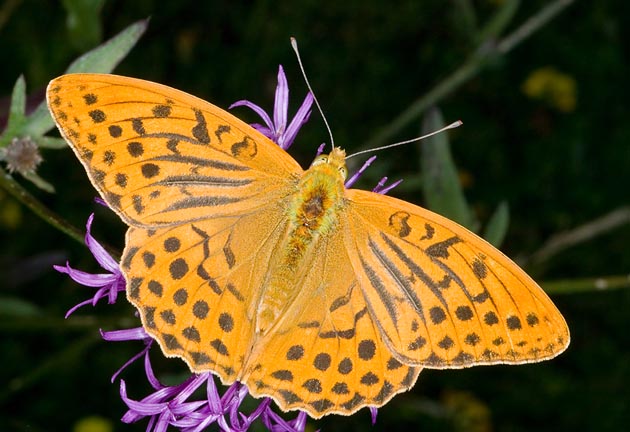
Argynnis paphia males chase, like a female, a moving orange papery butterfly © Giuseppe Mazza
The world of the insects, as well as, in general, that of the invertebrates, is a vast and very hard field of study for the biologist, due to the quite numerous existing reproductive strategies.
In the specific of the Lepidoptera, the matter is quite complex.
It is not possible, or at least fruitful, to schematize as is done for several orders of vertebrates, the different reproductive strategies utilized by the lepidopterans; it is better therefore to give some more classical and more studied examples, which may give an idea of how much the Nature enjoys to render simple what is unlikely complex.
Evolutionally speaking, in the various forms of mating of the insects, the eyesight, the smell, the touch and the hearing may all be involved and may be highly specialized for such purpose.
Usually, it’s the male who actively looks for the partner.
In the case of the butterflies, the colour and the movements of the female have great importance; in the butterflies of the genus Argynnis, the male will chase a fake butterfly, made of paper, if coloured in dark orange thus imitating the female and the attraction will be even greater if the papery wings move.
The male of the butterfly Satyrus semele is attracted by the flight characteristics of the female who may be, also in this instance, imitated by a small piece of paper, after having done the proper modifications.
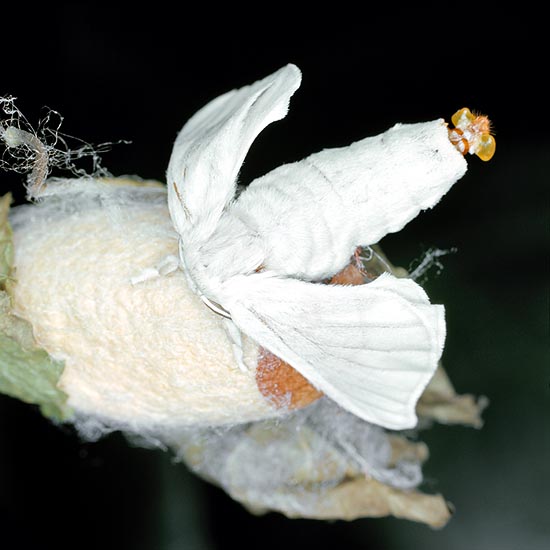
Bombyx mori females emit irresistible pheromones from abdomen apex © Giuseppe Mazza
But the female is also equipped with an “odouriferous gland”, placed in the rear extremity of the abdomen, which may carried out for increasing the attraction power.
Actually, most of the feminine butterflies hold and organ emanating odour, under form of pheromones, and those waiting for being fecundated assume a characteristic position, the so-called “posture of appeal”, with the odouripherous organs well in sight.
The male, on the other hand, is particularly conformed for recognizing and localizing these odours.
This is quite evident in the Saturniids (Saturniidae), in the Bombicids (Bombicidae) and in the Lasiocampids (Lasiocampidae), in most of which the females are slow and sedentary; for instance, the females of the Silkworm (Bombyx mori) are unable to fly, whilst the females of the genus Limantrid (Orgyia), are almost completely lacking of wings.
In these insects, the capacity of mating depends from the ability of the males in discovering, with their active flight, the waiting receptive female.
In all these species, the male is equipped with enormously developed feathery antennae whose only function seems to be that of detecting the odour of the pheromone emitted by the females, also from very far away.
In an experiment done by some Austrian entomological biologists in the seventies of the XX century, some males of Chinese saturnid (Arctias selene) were marked and then freed at 11 km of distance from the females kept in captivity. In the 26% of the cases, they were able to find the right way, whilst the 46% succeeded from a distance of 4 km.
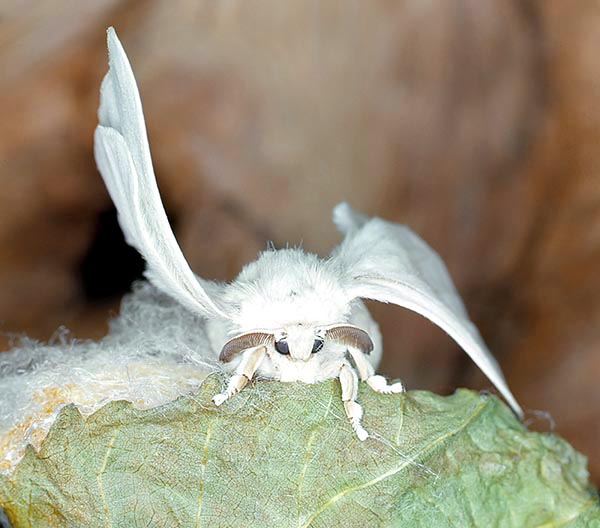
Males come running, perceiving them even kilometres far away © Giuseppe Mazza
Similarly, the male of the saturnid Collosamia promethea, another enormous silkworm, is not influenced by the colouration of the conspecific female, even if the same is rendered abnormal, by painting it, and not even attracted by females enclosed in a glass container or by others to which the abdomen has been taken off, but is strongly attracted only by the abdomen (where the odouripherous gland is located), or even by places where the female has rested.
The male of the genus Limantrid (Orgyia) will try to mate with pieces of absorbing paper imbued with drops of the secretion of the feminine gland.
The odouripherous liquid extracted from the apex of the abdomen of the female of Gypsy moth (Lymantria dispar), is regularly used in North America for catching the males of this lepidopteran, not for reducing the entity of the plague they may cause, but for verifying f it has spread in that particular location.
Many experiments have been performed for studying these sexual appeals, particularly for what the silkworm is concerned.
The odouripherous liquid (containing the pheromone) has been extracted from the apex of the abdomen of 500.000 females of Bombyx mori and finally they have obtained the pure active substance.
Chemically, it is a simple alcohol, with two double links in the chain, whose gross formula is C16H30O; this has been the first animal pheromone characterized in the history of the humanity. This happened n the seventies of the last century.
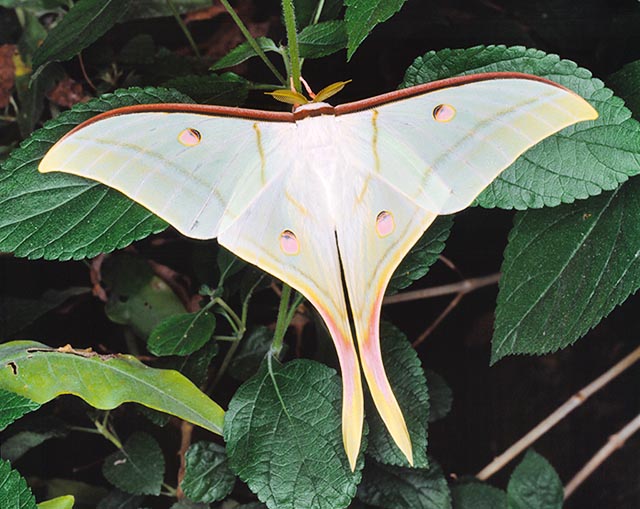
But record belongs to Actias selene males who find 11 km far female © Giuseppe Mazza
In order to find the presence of this substance during the chemical process done for isolating it, the entomological biologists suggested to the organic chemists, who were melting the secretion of the abdominal glands in petroleum ether, to dip a straw glass into the solution for bringing it closer to the antennae of a male.
The smallest quantity of this substance which, dissolved in a cubic centimetre of ether, gave a reaction in the male, was defined a unit of “attractive-perfume”; this represents a typical case of biologic test.
When the chemists got the pure active substance, they saw that one unit was contained in 10-10 micrograms of secretion, that is, in one ten-billionth of gram!
It is interesting to note that the male replies only to this odour; if other strong odours are present, they do not disturb it at all!
This means that the pheromones are highly species-specific.
But not only the female emits these odorous stimuli; in many males of lepidopterans, special glands produce perfumes having an aphrodisiac function, exciting the female thus preparing her to accept the courting partner.
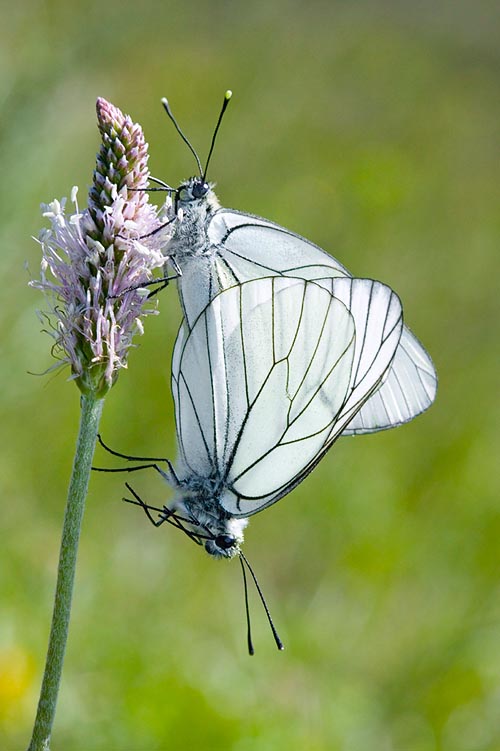
Aporia crataegi. All is good and each species has own mating rituals © Giuseppe Mazza
For this purpose, the males have particular structures consisting in tufts of small scales placed on the abdomen, on the legs or on the wings, which may be rapidly opened and expanded, in way to diffuse the odorous substance emitted by gland placed at their base.
These scales have complex and showy forms and are formed in way to hold the odour and disperse it rapidly at the right time.
A clear example of this is the male of the butterfly Eumenis (Satyrus) semele.
Like in all Satyrids (Satyridae), the odouripherous scales of the male, or “androconi”, are placed on an elongated surface which crosses obliquely the forewings. These scales have bowed extremities similar to the flowery top of some herbs from the field.
The nuptial parade is very beautiful: the male places in front of the female, opening the wings in way that this last with its antennae may touch the androconial scales, at this point the excitement will be at the top and the two insects will mate by means of the genital orifices, present in the terminal part of the abdomen.
Several other examples exist, where the eyesight, the hearing, the touch and the smell are more or less involved at various species-specific levels.
It is fascinating to see that insects like the butterflies and the moths, which may at first sight not compete for complexity, with animals having greater dimensions, from hundreds to thousands of times, such as reptilians, birds and mammals, have an arsenal of reproductive strategies of such an disconcerting complexity.
Concluding, we have to say that, after the discovery of the first pheromone in the seventies, the organic chemists have started to synthesize thousands of molecules from glandular secretions, from species, genera and families of insects that the biologists were furnishing them.
This has found then a very useful application field in agriculture and in forestry, entering the more general area of the “biological control”; the combined work of biologists and chemists (the first in nature, the second ones in laboratory), on such substances, has caused the birth of a discipline called “Semiochemistry”, the chemistry of the signals. Nowadays, some evolutive biologists draw the taxonomy and the evolution of the Lepidoptera, considering also the evolution of such signals, in addition to their palaeontology, morphology and ecology.
Natural and Evolutive History of the partial and complete “Metamorphosis”; how to change identity partially or completely
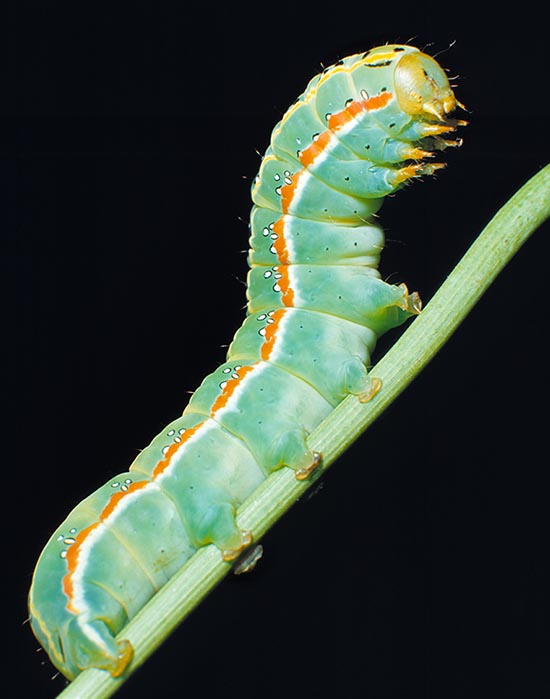
Xylena exsoleta caterpillar. Folds smooth growing then skin changes © Giuseppe Mazza
But let us now treat about the phenomenon of the complete “holometabolic” and of the incomplete or partial or gradual “hemimetabolic” metamorphosis, dealing for now only the aspect of their Natural and Evolutive History (as the physiology will be treated later on in the text), for remaining even more open-mouthed about “things of the Nature” or about “nature of the Things”.
As soon as the Arthropods (Arthropoda) did acquire a hard cuticula, the phenomenon of the “moulting” became for them necessary for being able to increase their size.
The tenderest teguments, such as the cuticle covering the whole body of the caterpillar, can be provided with a superficial layer, or “epicuticle”, rather ample and rich of folds.
This allows space for the accretion; the superficial folds smooth out, other chitin and protein add to the inner layers of the tissue and, in the limits given by the extensibility of the cuticle, the body may go on in growing.
The most impressive example of this process is given us by the queen of the termites.
As the reproductive organs of this insect develop, the abdomen may increase in length, even up to fifty times of its original size.
But the rigid sclerotised structures, such as the cephalic capsule, which in many insects has to support the mandibula, the robust skeleton of the thorax or the legs once hardened, cannot get longer any more.
The “moulting” process, in a broad sense, is formed by a very complex series of activity and is set in motion by the secretion of special cells contained in the brain.
This secretion acts on the internal secretion glands (endocrine), which are located n the head and in the thorax (called ventral and thoracic glands), which, as response, in turn secrete the “moulting hormone”. Such process is utilized by the species of heterocerous lepidopterans, whose larva/caterpillar forms the chrysalis during the vital cycle inside a silky/chitinous cocoon, where the metamorphosis takes place. Please see the Bombyx mori.
The exuviation, the mechanism taking the nocturnal butterfly out of its cocoon, is guaranteed by special enzymes, capable to dissolve the chitin and the silky protein forming it. These enzymes are poured in the so-called “exuvial liquid” which is secreted by the mature insect, or “imago” emits for getting free from its capsule, which now has become a narrow prison.
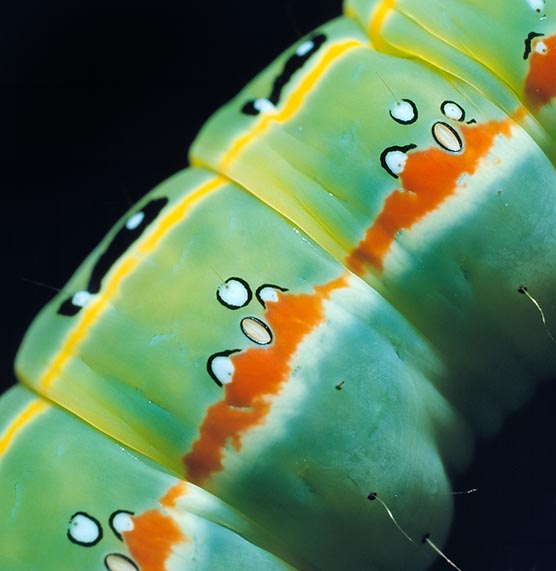
Segments close-up, with tracheas entry hidden by drawings © Giuseppe Mazza
But during the incredible complete “holometabolic” metamorphosis inside the cocoon, by means of which there is the passage from the stage of caterpillar, or, better, of chrysalis or pupa, to the stage of butterfly, there will be also a continuous destruction and reconstitution of the covering tissue of the insect, by means of such enzymes; in the case of the caterpillars, with soft covering, the 90% of the old covering is digested and only a very thin film, called “exuvia”, is abandoned.
In most insects, among which the Lepidoptera, as soon as the adult stage is reached, the glands with internal secretion producing the hormone of the moulting, that is the thoracic and ventral glands, regress until they disappear; the whole is preceded by the extinction of the signals which originally depart from the cerebral cells.
This is a characteristic which accompanies the maturity of the insect.
Not much is known, till now, on how is regulated the activity of the thoracic and ventral glands, but it is known that it is stimulated by another hormone produced by nervous cells of the brain, called “neurosecretive cells”.
Even less is known, from what and how these last ones are controlled; but what matters is that the fundamental centre which decides if the phenomena of moulting and metamorphosis, as well as of development, most or not activate, turns out to be staying in the brain of the insect, therefore also of the lepidopteran. In the case of the bugs, for instance, the strong stretching the abdomen undergoes, after that the hematophagous hemipteran has ended his blood meal, causes the nervous stimulus in the brain, which starts the above mentioned hormonal cascade.
In some winged insects, that is afferent to the cohort of the Pterygotes (Pterygota), we note a new characteristic. During the juvenile stages, these insects resemble more or less to the atterian species called Apterygtes or Atterygotes (Apterygota): they are equipped with wings and do not reach the sexual maturity; they nourish, grow up and suffer a series of successive moults, in which we observe a progressive enlargement of the wings outlines, but very few other changes.
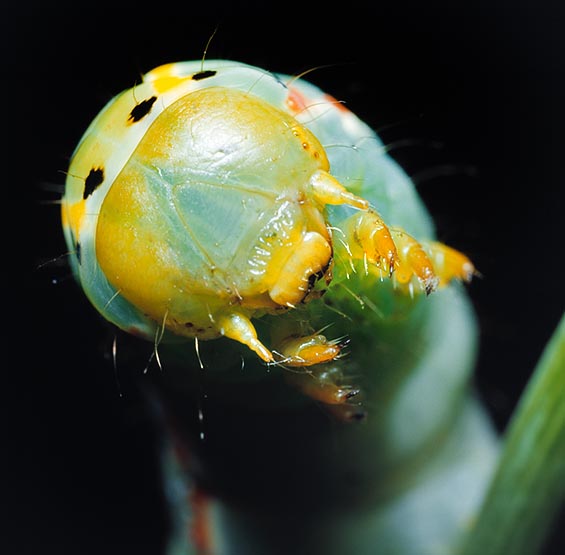
Formidable teeth apparatus. Nailed forelegs to seize leaves © Giuseppe Mazza
Finally, thanks to a last moult, these pterygotan insects undergo a spectacular transformation, a real metamorphosis, which however, being partial or incomplete, the entomological biologists call “hemimetabolous”; more usually, “heterometa- bolous”, which can then be “paurometabolous” or “hemimetabolous”, depending on the species.
The sexual and reproductive organs assume, ripening, the final shape, completely developed wings do appear and often the structure and the shape of the cuticle are deeply altered, also in the colour.
This is what happens in one of the two superorders, in which the cohort of the Pterygotes (Pterygota) is subdivided, which includes the cockroaches, the orthopterans (locusts, grasshoppers and crickets), the hemipterans (bugs, fleas, etc.) and the odonata anisopterans (dragonflies), etc., called of the Exopterygotes (Exopterygota).
Once the wings and the sexual organs have developed, these insects do not change any more.
Only one odd exception does exist, that of the mayflies, where the aquatic larva or “naiad” generates a winged insect called “subimago”, which at once moults for forming the real adult insect, the “imago”.
In the other superorder of winged insects, the Endopterygotes (Endopterygota = Holometa- boles), to which are rightly afferent the lepidopterans, besides many species of coleopterans, dipterans like the flies and hymenopterans like the bees, they have adopted and even newer and more astonishing expedient. In most lepidopterans the nymph as soon as it gets free from the larval involucre, has an appearance where the wings appear for the first time; this stage is also called, in a broad sense, pupa.
Furthermore, like in many species of coleopterans, the nymph has not only rudimental wings, but legs, antennae and buccal parts, which are not capable to move, but protrude from the superficial involucre and will be useful, later on, as sheaths for the mobile structures which will develop inside them, in the adult insect.

Caterpillar, pupa and imago of Spurge hawk-moth (Hyles euphorbiae) © Giuseppe Mazza
Almost immediately, the wings, the buccal parts, the legs and the antennae adapt ones to the others like jointed pieces in a puzzle; then, a cementing substance covers all the organs, which stick firmly, so that in the completely formed chrysalis of a butterfly or of a moth, the various parts are visible in surface only in their outlines; this represents the aforementioned pupa obtecta.
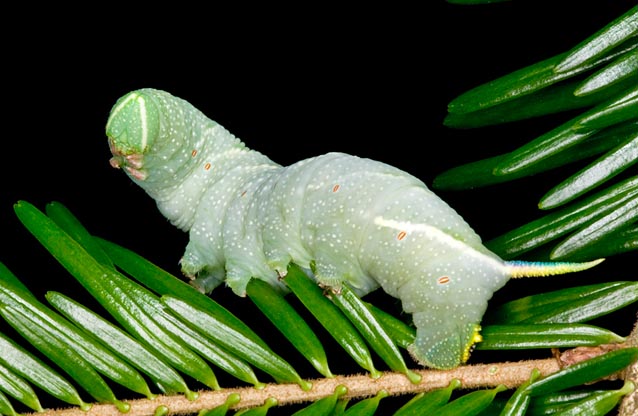
Wagging puppy? No, Lime hawk-moth caterpillar, accidentally fallen on a conifer © Mazza
In the nymphal stage, the insect enters a sort of “suspended animation”, whereby the metabolism slows down to basal values and the animal will not need to eat; it is like, after some entomological biologists, it would be a second time in the stage of egg, during which it renews the embryo stage.
As we have mentioned before, in the heteroceres-nocturnal, the nymph often encloses in an underground cell, or in a silky cocoon, built rightly by the mature larva.
Different are, on the contrary, the protection puparia of the domestic fly and of the blowflies.
The real larva of the fly, which is white and quite frail, is enclosed inside a brown or black “puparium”, which, in reality, represents the last stage of the larva.
Going back to the lepidopterans (but the same thing, done the due differences, applies for the flies, the coleopterans and the bees), in the nymph takes place a quite complex development, at the end of which the insect getting out will be remarkably different from all the previous stages.
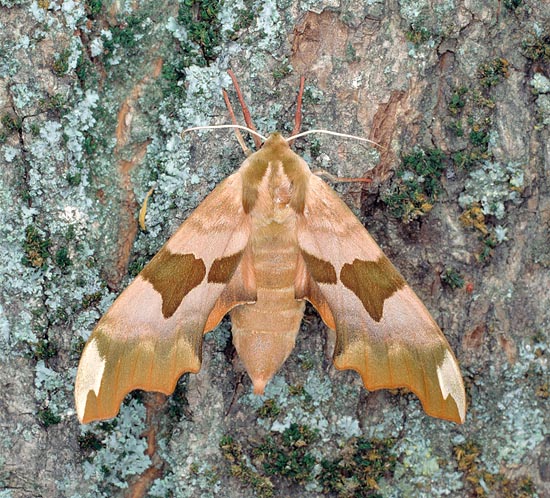
Same, adult, more serious look. May be 55-70 mm. Very diffused © Giuseppe Mazza
The insect has undergone a “complete metamorphosis”.
These surprising transformations raised some problems which, since the old times, have kept busy the minds of the biologists.
How are such changes of shape regulated? How did they originate during the evolution? What is the meaning and what the origin of the nymphal stage?
The first question is that to which is easier to give an answer, even if, still now, in a fairly superficial manner.
Immediately behind the brain of the lepidopteran (we remind that this applies also for the other holometabolous and hemimetabolous insects, where, however, the last ones have different rhythms), is placed a tiny internal secretion gland called “corpus allatum”.
During the juvenile stages, this gland secretes a hormone commonly called “juvenile hormone”, other authors call it “neotenin”; till when this substance circulates in the blood (more precisely, in the hemolymph), the epidermal cells, when the insect moults, deposit a cuticle of larval type.
It looks like it is the brain to decide if the corpus allatum, must or not secrete the juvenile hormone.
In the case of the exopterygote insects (bugs, grasshoppers, crickets, cockroaches, etc.), this hormone is present in their larval stages; reached the last larval stage, which in the orthopterans (crickets, grasshoppers) and in the hemipterans (bugs, fleas), happens by the fifth moult, the neotenin starts lacking and when the insect moults again, transforms in adult.
The same principles apply for the endopterygote insect, therefore, lepidopterans, coleopterans, bees, etc., but with one difference. If the corpus allatum is taken off surgically from a young caterpillar, this one moults in a small chrysalis which, in turn, will originate a tiny butterfly.
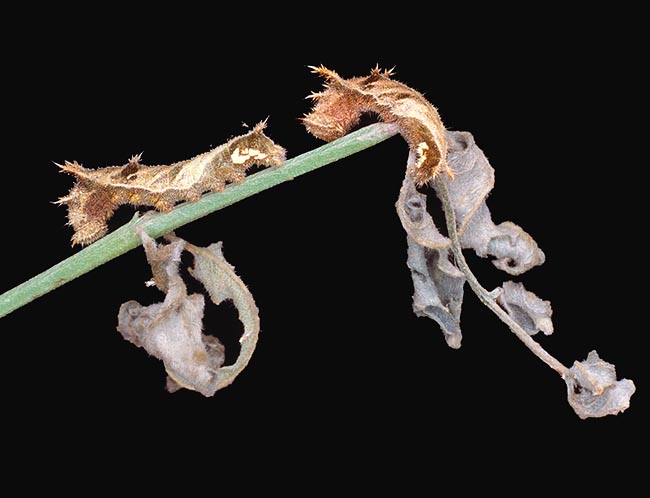
Caterpillars apply many ruses for surviving, colors, poison or this Neptis hylas mimicry © Giuseppe Mazza
On the other hand, if we take off the corpus allatum from a caterpillar at its last larval stage, it transforms in a monstrous creature with characteristics standing between those of a chrysalis and an adult butterfly.
From these ones and other experiments, the entomological biologists have deduced that the form of caterpillar produces when there is present a great quantity of juvenile hormone, the form of chrysalis only in the case there are only small traces of the same, and the adult form (butterfly), only hen this hormone is totally missing.
It is more difficult to reply to the second question (how did they originate during the evolution?). The most likely hypothesis done by the evolutive biologists and the entomological biologists is that there has been an independent evolution of the different “stages” of the insects.
The shape of an animal (invertebrate as well as vertebrate) is the outcome of a series of processes of development, which are regulated by hereditary “genes” existing in the chromosomes of the nucleus of the cells. The genes furnish the “heliographic” copy of the biological project of the whole, where the shape and the characteristics of the animal are foreseen.
It is known that in the insects, for instance the silkworm, some genes are those determining mainly the characters of the larva, whilst others are specifically responsible of the characters of the adult insect. In the form of caterpillar may take place huge variations although no perceptible differences may be found in the resulting butterfly.
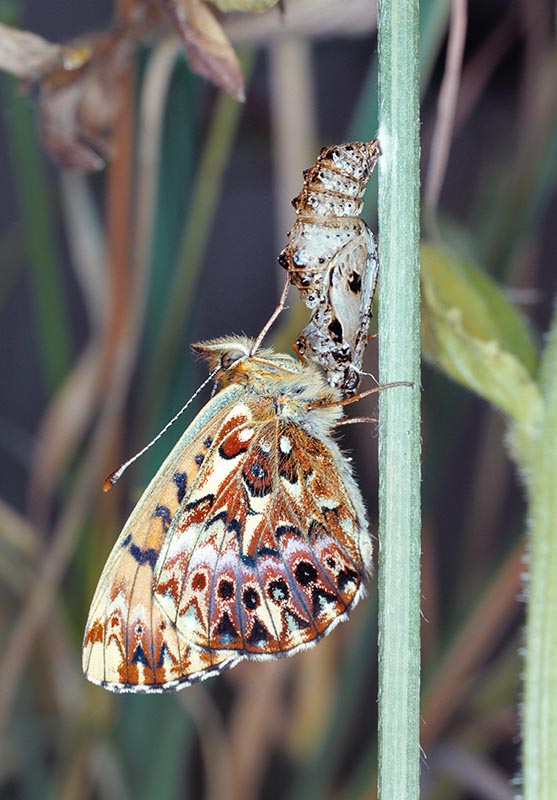
Finally, like this Clossiana titania, it’s time to leave the pupa and fly © Giuseppe Mazza
Likewise, there are some species of lepidopterans, such as Acronycta psi and Acronycta tridens, afferent to the family of the Noctuidae, whose adults practically cannot be distinguished, whilst their larvae are completely different; conversely, many exist virtually identical when larvae and greatly different when adult.
As soon as two series of partially independent genes are separated in such a way, it is easy to understand how the larva and the adult may evolve and change independently one from the other.
So, when the larva and adult insect find themselves living in different habitats and nourishing of different foods, they will become more and more different till when a spectacular “metamorphosis” will be necessary for ensuring the passage from a form to the other.
Perhaps, it is not an entirely accidental coincidence that larvae of insects absolutely unrelated, when they are living in the same ecologic conditions, assume for eco-evolutionary convergence, a similar appearance; once again, after me, this shows that it is always the habitat (which acts on the genetic substratum, but also on the somatic one), to be the main force to which belongs the historical-evolutive link of a species, animal as well as vegetal.
In fact, the leaf-eating larvae, the tenthredinids, hymenopterans of the genus Symphytes, appear remarkably similar to the caterpillars of the lepidopterans and to the larvae of certain coleopterans, afferent to the family of the Chrysomelidae and to those of the Tipulid (Cylindrotoma splendens), which nourish in the same manner on the leaves.
We can therefore consider that the metamorphosis, complete as well as partial, got its origin as result of the evolution diverging between the various stages of the vital cycle, on one hand of the juvenile stages and of growth of the insect, on the other, of the adult and reproductive one.
Probably, the origin of the nymph must be looked for in the same direction, and namely, as independent evolution of an intermediate stage, the form of which is still controlled by other genes and which serves to fill the large void, between the structure of the “larva” or “caterpillar” and that of the adult, in this case, the butterfly.
It is not difficult to imagine that a similar protected and transitory stage between larva and adult may have had a selective value during the course of the evolution of the species. How then could it happen that these fundamental and extraordinary changes of form have come to depend from the control of the juvenile hormone?
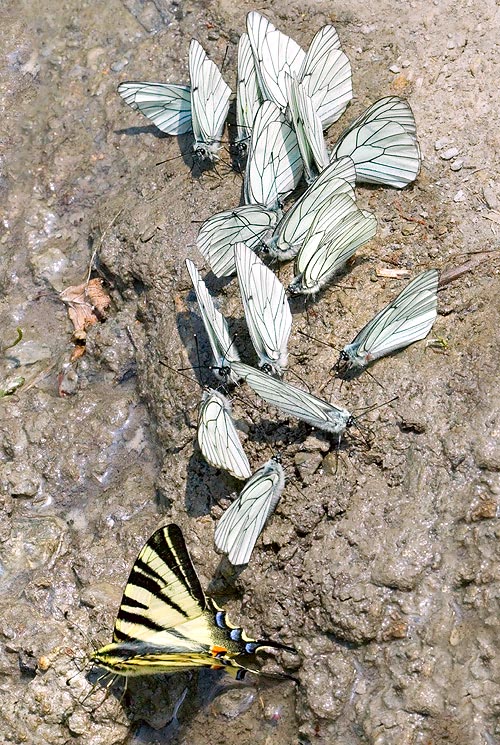
Time comes to meet friends for a drink at stream’s bar © Giuseppe Mazza
Since the fifties, and then confirmed up to now, it has been discovered that this hormone (or some chemical substances closely akin which cause the same responses) is widely present among the animals and the plants, which is why in bio-chemistry it is said to be an “ubiquitous hormone”.
In fact, it has been extracted from many invertebrates, from some bacteria and starches, from the soya beans and from several organs of mammals, man included.
This natural compound is the “Farnesol”, an acyclic sesquiterpene alcohol, involved in the synthesis of the lipids, of the cholesterol and of the carotenoids.
This is a typical case, defined by the bio-chemists of “hormonal catching”; this phenomenon happens when any natural chemical substance, widely distributed in the animal, vegetal, prokaryotic, protistic and of the fungi as well as mineral kingdoms, or which, at times, is a simple secondary product of the metabolism, without any physiological importance, is utilized as hormone by some animal or vegetal species.
Then, at some point in the evolutive history of a species, a gland, in this case the corpus allatum, utilizes it as its informative vector, acting by means of it on various organs, in the case of the lepidopterans and of the other holometabolous insects on the epidermal cells which form the cuticle, causing specific responses.
Like a key opening a door, this hormone activates a series of genes, which are responsible of the larval stage or of the caterpillar’s one.
For this reason, it is found all over the body, when expressed, in such a way that the entire insect is at the larval or nymphal stage.
Whereby, when ambient factors, such as an inadequate temperature, break such hormonal balance, some monstrosities form as consequence of a non balanced expression of the series of genes activated by it.
For instance, in the lepidopterans as well as n the coleopterans of the genus Tenebrio, there may be instances of “prothetely”, the insect appears in a form half way between larva and nymph, or of “metathely”, where it stands half way between the stage of nymph and of adult.
In order to conclude this aspect of the biology of the lepitopterans, we mention a phenomenon (present in crowd of other insects), essential for the survival of the insect, which evidences with a stop in the growth during period when are present adverse environment situations, such as extreme temperatures (high or low), lack of food and water, etc.
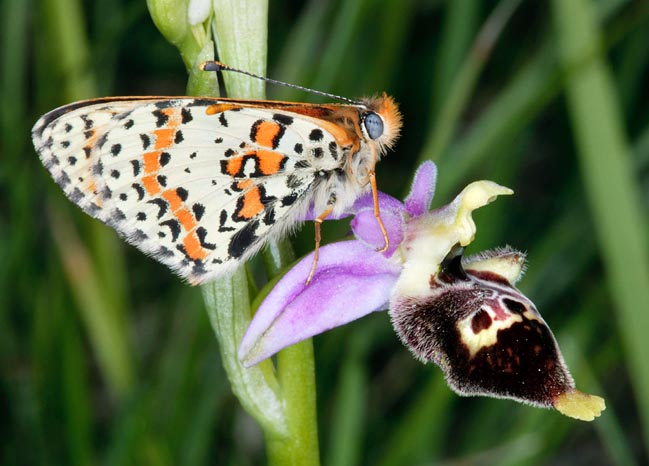
Or fall asleep, sated, on an orchid, like this Melitaea didyma drunk by Ophrys nectar © Giuseppe Mazza
This phenomenon, or strategy, is called “diapause” (in the vertebrates, fishes, amphibians, reptilians, birds and mammals whatever, it may happen at the level of the embryo under development).
The diapause (condition of dormancy, where the metabolism decreases to basal values) is a physiological means used for surviving to the adverse seasons, and is particularly frequent in the temperate zones where the rigid winter is not suitable for the development of the insects.
This may happen also in some tropical zones, where there is the dry season, that beyond which the insect must survive.
The causes which lead an insect, in the specific a lepidopteran, like, for instance Araschnia levana or Lasiocampa cuercus to the diapause, may be several; the stimuli which may induce a chrysalis to enter diapause, can be of a photoperiodic nature (the irregular variation of the photoperiod): to one of its alterations it responds entering diapause. For instance, in the Large cabbage white (Pieris brassicae), when the hours of light are less than twelve.
Others are stimulated by the variations of the temperature; for instance, when carrying chrysalises of tropical butterflies to greater latitudes these enter immediately diapause.
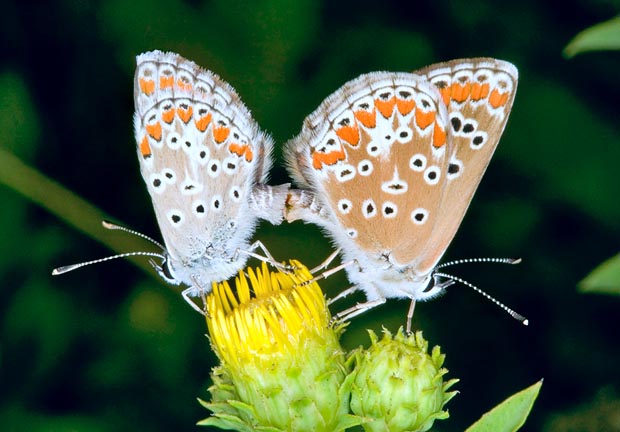
Without ignoring the sweet life duties like these Aricia agestis in love © Giuseppe Mazza
In the event that, for any reason, the vital cycle of a lepidopteran has not been able to protect itself with the diapause, at the occurrence of local adverse situations, but which by not dying has completed the cycle generating the adult, this one will appear rather shabby also in its livery, if compared with whom having gone through the diapause; these specimens are called not well and physiologically developed forms (prorse). Many are, still nowadays, the studies made by the bio-chemists intending to clarify which are the hormonal cascades involved in such process.
On the other hand, the entomological biologists Kirby and Spence in 1815, in the introduction of their magnificent text “An Introduction to Entomology” wrote: To bring insects hibernation (diapause) to the simple and direct influence of the cold, is equivalent to think that one of the most important acts of their existence, may be abandoned to the blind guide of the sensations which, in the changeable climatic conditions of Europe, would lead them towards continuous and fatal mistakes… We can be sure that the Creator has not entrusted the salvation of such an important part of His creatures to a so much misleading guide.
General physiology of the Holometabolism and of the Hemimetabolism
While quickly retracing, summarizing them, the phases (for perceiving the differences) between the hemimetabolous or incomplete metamorphosis and the holometabolous or complete one, we can say that after the egg hatching, in the exopterygote insects (orthopterans, odonates, cockroaches, etc.), the larva which gets out from it, called also “neanid”, of a “not much different” look from the adult’s one, will proceed gradually in the development, up to a final stage called “imago” through a consecutive series of moults, accompanied by a growth with gradual appearance of the wings, in the stages called “nymph” and, finally, with the maturation of the genital apparatus; from this gets out the adult insect and we shall have that the juvenile hormone will not be secreted ant more, due to the total regression of the corpus allatum.
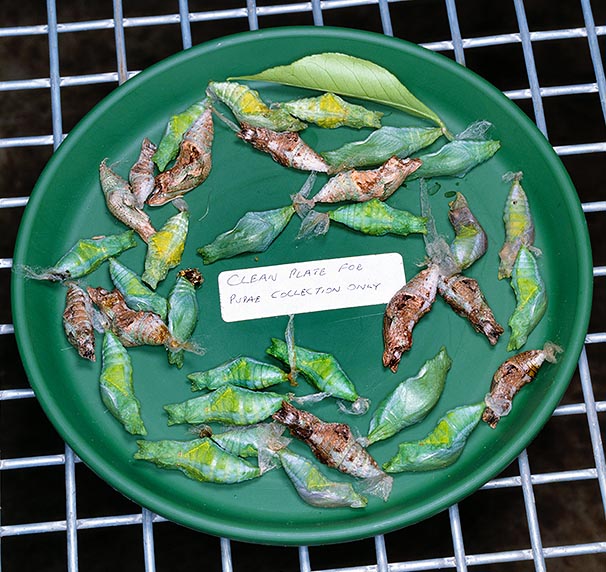
A dish with pupae, in a lepidopterans studies centre © Giuseppe Mazza
In the Lepidoptera, like in all the holometabolous, or with complete metamorphosis insects (flies, blowflies, bees, coleopterans), the physiology is rather more complex.
In this case, at the hatching, from the egg comes out a larva differing completely from the adult, as we have already discussed, which, initially, grows through a series of consecutive moults, till when, reached a moult called “critical”, covers with a brand new cuticule, transforming in a “pupa”, which, in the lepidopterans, is obtecta.
As mentioned before, during the time of pupal life, an enormous series of changes of the internal and external structure of the insect takes place. With the final moult, the pupal involucre gets lost, and from that emerges the imago or adult.
Both types of development are characterized by a periodical change and renewal of the chitinous exoskeleton: nonliving acellular cuticular involucre, which, with its persistency should limit the development and the growth of the insect. This phenomenon is now well known as “moult”. During each moult, the old outer cuticule detaches from a new internal one, thinner, which has formed on the surface of the body.
This separation, between the old and new cuticule, is done by an enzymatic activity. The old cuticle then opens along determined lines of incision and the animal gets off from it thanks to a muscular effort, phenomenon known under the term “hexuviation”. As soon as the old cuticula is lot, the animal dilates by introducing air into its own tracheal apparatus and so increases the volume, under the new thin cuticle, still elastic. When, later on, the new cuticle will be thickened and hardened, the air in excess will be again pushed out, but the animal inside its new exoskeleton has now room available for the further growth, till when the process will have to repeat.
The extensive structural changes happening during the pupal status, in the specific, of the lepidopterans, entail vast demolitions of tissues and their replacement with new ones, which develop from small groups of undiversified resting cells, called “imaginal discs”. The cell biologists tell us that all these complicated processes are ruled by a complex system of hormones.
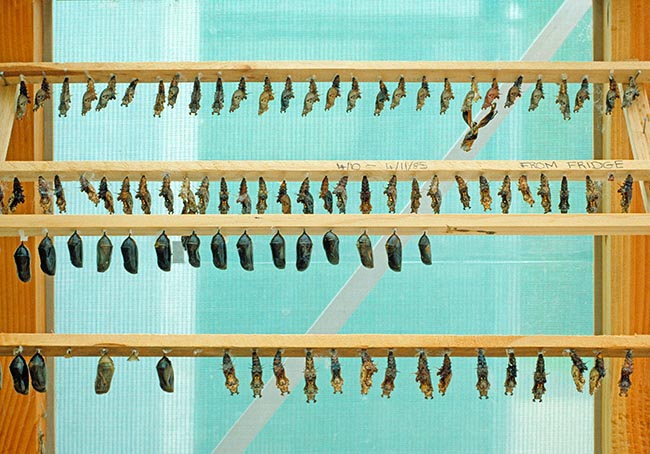
Here they check, on various species, the impact of cold on chrysalises © Giuseppe Mazza
In a manner analogous to what occurs for the pituitary gland in the vertebrates, which is under the control of the neurosecretory centres of the hypothalamus, thus also in the insects, various endocrine glands are activated by neurosecretory cells, contained in the “supraesophageal ganglion mass”.
Their secretion, of peptidic nature, accumulates in other structures of nervous origin, called “corpora cardiaca” and from here, freed into the hemolymph, regulates the endocrine activity of other endocrine glands, of non nervous nature, the “thoracic and ventral glands”; these produce a steroidal hormone, the “ecdysone”, called also the moulting hormone, which regulates the rhythm and the sequence of the successive moults described before.
Finally, there are other endocrine glands, also non nervous, placed on the sides of the fore part of the aorta, close to the “corpora cardiaca”, we have already met them, and are the “corpora allata”, which, as we well know, secrete the “juvenile hormone”, or neotenin, which is a methylic ester of a special unsaturated fatty acid controlling the conservation of all the structures of larval type. Till when goes on, from the “corpus allatum”, the production of the neotenin, from moult to moult, the stages of development remain larval; however, at a given time, the causes of which are not yet known, the “corpora allata” reduce their activity and finally cease it, then happens the metamorphosis; the juvenile structures therefore, are replaced by the adult ones, by the ecdysone, which starts the expression of a sequence of genes, previously not expressed, to which correspond the morpho-physiological characteristics of the adult. After the metamorphosis, the pre-thoracic glands reduce and disappear, reason why the insect does not moult any more.
The essential difference between hemimetabolous and homometabolous insects seems simply to consist in the fact that in the first the depletion of the secretion of neotenin is a very slow process, much slower than in the second ones; this means that in the first, the “metamorphic crisis” takes rightly place gradually, during the various stages of nymph, whilst in the second ones, this happens in an almost immediate or explosive way, during the only one stage of pupa.
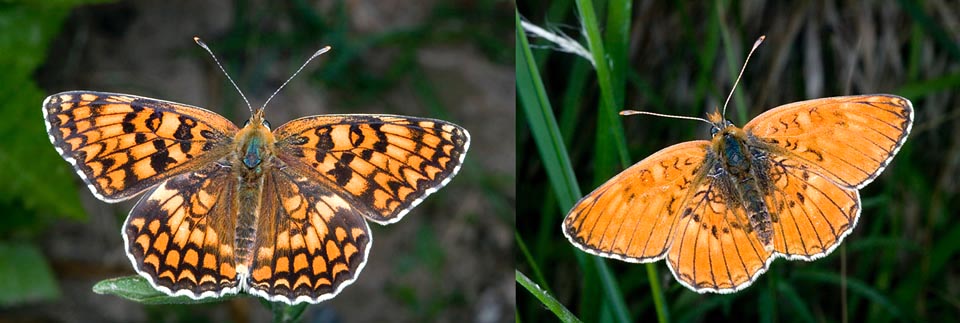
Also in nature, in coldest winters, aberrant forms may be born. It’s the case of Melitaeae phoebe, right, who almost lost its patterns © Giuseppe Mazza
During the metamorphic crisis, the “corpora allata”, which have ceased the production of juvenile hormone, begin the secretion of other hormones which determine the maturation of the reproductive apparatus of the insect.
My formation of field biologist and of zoologist, does not allow me to go on in the bio-chemical details, which go well beyond my preparation, but it is obvious that the cytologists and the bio-chemists will surprise us again with their studies.
Here we end this approximate text about the life of the lepidopterans and their biology, excusing ourselves with the entomological biologist colleagues, due to the quantitative approximation of the information, and, even if considering the taxonomy fundamental being a biologist, just as much as the mathematics for a physicist, for not having listed all the families, the genera and the known species, due to space constraints, which will be, however, treated in a more detailed way in the single texts.
